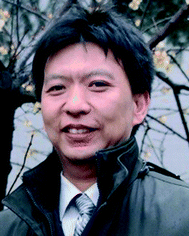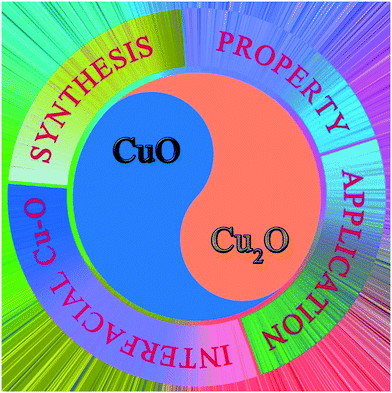Hollow CuxO (x = 2, 1) micro/nanostructures: synthesis, fundamental properties and applications
Shaodong
Sun
 *a,
Qing
Yang
a,
Shuhua
Liang
*a and
Zhimao
Yang
*b
*a,
Qing
Yang
a,
Shuhua
Liang
*a and
Zhimao
Yang
*b
aShaanxi Province Key Laboratory for Electrical Materials and Infiltration Technology, School of Materials Science and Engineering, Xi'an University of Technology, Xi'an 710048, ShaanXi, People's Republic of China. E-mail: sdsun@xaut.edu.cn; liangsh@xaut.edu.cn
bSchool of Science, State Key Laboratory for Mechanical Behavior of Materials, MOE Key Laboratory for Non-Equilibrium Synthesis and Modulation of Condensed Matter, Center of Suzhou Nano Science and Technology, Xi'an Jiaotong University, Xi'an 710049, ShaanXi, People's Republic of China. E-mail: zmyang@mail.xjtu.edu.cn
First published on 25th September 2017
Abstract
Hollow micro/nanostructures possess fascinating physicochemical properties that would generate great application potential in the fields of catalysis, sensing and energy conversion. In the past decades, much more efforts have been employed in the exploration and enrichment of copper-based binary oxides, CuxO (x = 2, 1); thus a number of CuxO micro/nanostructures with well-controlled ingredients and morphologies have been rationally synthesized and applied. However, a thorough summary on hollow CuxO materials has been lacking so far and it is urgently necessary to further promote the progress in novel function-directed CuxO-based micro/nanostructures. In this review, we will comprehensively summarize the important advances in hollow CuxO micro/nanostructures with tailored morphologies, including the universal synthesis strategies and formation mechanisms, the interfacial Cu–O atomic structures as well as the intrinsic properties, and their potential applications. Remarks on emerging issues and promising research directions are also discussed.
1. Introduction
As a promising architecture, hollow micro/nanostructures with large specific surface areas, low density and superior charge/mass transport and high permeability have been attracting much attention in the past years.1–9 In regard to the potential application, hollow micro/nanostructures generally act as supports for catalysts/drugs or are directly used as active components in some fields. In particular, the active components supported onto/into hollow supports would exhibit excellent performances compared to the unsupported counterparts.10–13 As a result, to accurately regulate the size, shape, crystallinity, composition, defects, building blocks and hybridization of hollow micro/nanostructures is imperative.Copper-based binary oxides CuxO (x = 2, 1), as typical p-type semiconductors, have been widely investigated for a long time because of their unusual optical and electrical properties in the fields of catalysis, sensing, energy conversion and chemical templates,14–22 which have employed tremendous endeavors on the rapid development of CuxO with controllable microstructures. To date, various CuxO with tailored morphologies have been developed. As for Cu2O, morphological micro/nanostructures, including three-dimensional solid architectures with tailored surfaces,23–82 hollow and porous structures,83–122 and low-dimensional nanostructures,123–130 have been successfully synthesized. As for CuO, the configurations are mainly nanowires,131–142 nanobelts,143–146 and hierarchical147–162 and hollow architectures.163–180 Among them, hollow CuxO micro/nanostructures with controllable features are still one of the hottest and challenging topics for both fundamental studies and technological applications.
Optimizing the interfacial atomic structures of CuxO micro/nanostructures can provide distinct abilities for improved performances. Great efforts have been devoted to the modification of Cu–O interfaces, which is favorable to the design and synthesis of hybrid CuxO-based heterogeneous architectures with tunable performances.181 Inspired by this viewpoint, selective construction of function-directed hybrid CuxO-based hollow micro/nanostructures can obviously bring enhanced performances for practical applications.182–186 Therefore, the development of synthesis methodologies of various hollow CuxO micro/nanostructures and their hybridizing forms would provide a good pathway to comprehend the intrinsic principles of the formation mechanisms as well as the fundamental theories of the interface-dependent performances. Additionally, hollow CuxO can interestingly act as sacrificial templates and/or substrates for in situ synthesizing of the desired hollow or hybridizing architectures. In particular, a Cu2O-templated strategy for the synthesis of definable hollow architectures has been demonstrated previously.9 However, the hollow CuxO template-based synthetic strategy for preparing novel hybrid copper-based nanocomposites is still in its infancy.
Although several references have reviewed the advancements in Cu2O and CuO,14–19,22,138 a thorough review on hollow CuxO micro/nanostructures has been rarely reported so far and it is urgently necessary to further develop the novel function-directed copper-based oxides. Therefore, it is imperative to individually summarize the promising hollow CuxO micro/nanostructures. Herein, this review is devoted to comprehensively highlighting the advancements in hollow CuxO with tailored morphologies (see Fig. 1). We will start with a summary on the general synthetic strategies and formation mechanisms of hollow CuxO micro/nanostructures. Next, the intrinsic properties and the interfacial Cu–O atomic structures of hybridizing hollow CuxO micro/nanostructures (such as CuO/Cu2O and Cu/Cu2O) will be highlighted. Additionally, the potential applications of hollow CuxO micro/nanostructures are reviewed. Remarks on emerging issues and promising investigation directions are also proposed.
2. Synthetic strategy and growth mechanism
In general, the synthetic strategies for preparing hollow architectures are mainly divided into two categories according to the formation mechanisms, the template-assisted and the template-free approach.5–9The template-assisted synthetic strategy has been extremely practiced to synthesize various hollow architectures,5 which can effectively control the morphologies, sizes, compositions and spatial arrangements of the as-synthesized products. Typically, hollow architectures can be synthesized by the following three-step process, namely, (i) the construction of templates, (ii) the direct synthesis of target architectures using the above templates, and (iii) the removal of templates (if necessary). So far, two types of templates have been developed to synthesize hollow architectures: (i) hard template (physical directing solid particle, such as metal–organic frameworks (MOFs),187,188 polystyrene spheres (PS),189–196 carbon nanotubes (CNTs),197–202 block copolymers (BCPs),203–205 molecular sieves,206,207 silica,208–210 anodic aluminum oxides (AAOs),211–218 and Cu2O (ref. 219–228)); and (ii) soft template (molecular assembly, such as emulsion droplets, surfactants, supramolecular micelles, polymer vesicles, polymer aggregates and gas bubbles).1,3,229–232
However, some drawbacks should be overcome in using hard-template strategies.3 For example, it is difficult to remove the hard templates by either a chemical or a thermal route, and the synthetic process is complex and high-cost. Soft templates are usually thermodynamically unstable, leading to uniform sizes and shapes, but the organic molecular assembly might affect the purity of the final products. Therefore, a green synthetic strategy with low cost, environmentally friendly, mild synthetic conditions and potential large-scale production should be greatly considered. The template-free approach is an alternative promising strategy to synthesize hollow architectures, which is principally of two types: self-template and self-aggregation.1,3
So far, the formation mechanisms involved in the synthesis of hollow architectures mainly include inside–out Ostwald ripening, oriented attachment, Kirkendall effect, oxidative etching and their combined strategies.1,3,6–8
Inside–out Ostwald ripening generally refers to a coarsening and recrystallization process in an almost saturated solution-phase system.233,234 Briefly, it involves the “dissolution of small nanocrystals or sol nanoparticles and the re-deposition of the dissolved species on the surfaces of larger crystals or sol nanoparticles, finally leading to decrease in the total Gibbs energy”.235 Thus crystallites located in the center regions dissolve and relocate on the surfaces of the aggregates, resulting in the formation of hollow interior spaces.236 Accordingly, the inside–out Ostwald ripening mechanism could act as a general strategy to prepare various hollow micro/nanostructures, which can be divided into the following two types.94 The first one is based on a three-dimensional (3D) random aggregation of initial nanocrystallites and core hollowing by the inside–out Ostwald ripening process, as shown in Fig. 2a. The second case is the combined “oriented attachment” and “inside–out Ostwald ripening” mechanism, in which random crystallites undergo an “oriented attachment” process to form a well-defined geometrical structure under a different set of reaction parameters, and then solid voids occur in the central part of the shape-defined aggregate through Ostwald ripening, leading to the generation of non-spherical (faceted) structures, as shown in Fig. 2b. Herein, oriented attachment often occurs before the Ostwald ripening process for the formation of a hollow architecture. In regard to the oriented attachment process, individual crystallites acting as primary subunits can directly merge with their adjacent crystallites to form a mesostructure with a similar crystallographic orientation to minimize the interfacial energy.237,238
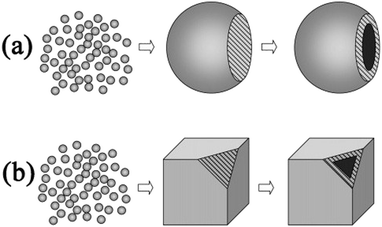 | ||
| Fig. 2 (a) 3D oriented attachment for solid nanocubes and creation of hollow interiors by Ostwald ripening. (b) 2D oriented attachment for formation of thin crystal planes and construction of hollow octahedra in a plane-by-plane manner. Hashed areas indicate the solid parts of nanostructures, and dark areas represent interior spaces. Reprinted with permission from ref. 94. Copyright ACS 2006. | ||
The Kirkendall effect is a classical atomic diffusion phenomenon for the construction of hollow nanoparticles,239,240 which can be attributed to an unbalanced mutual interdiffusion occurring through an interface of two different components. Vacancies can be generated at the interface and then move in the region of the fast-diffusing component. The coalescence of excess vacancies further gives rise to voids located at the initial interface and within the fast-diffusing element. Finally, the confined voids can condense and form a single hole, resulting in the formation of a hollow nanostructure.
Oxidative etching is a special route for achieving the structure evolution of Cu2O from the solid state to hollow cages/frames, in which both the etching agent and the dissolved oxygen play a crucial role in determining the final hollow features. The reaction process can be described by the following reaction equation (see eqn (1)).
| 2Cu2O + O2 + 4H2O → 4Cu2+ + 8OH− | (1) |
As expected, these strategies have been developed to synthesize hollow CuxO micro/nanostructures.181 However, an in-depth overview on the synthetic strategies and formation mechanisms of hollow CuxO with various morphologies is less reported. In this section, we will discuss the reported synthetic strategies for synthesizing hollow Cu2O and CuO micro/nanostructures and summarize the corresponding growth mechanisms.
In addition, spray pyrolysis is an effective strategy to obtain hollow materials, whereby precursor solutions are atomized and decomposed thermally to form particles. Notably, in order to generate the hollow architecture, an in situ blowing agent is imperative. For example, the introduction of sucrose and hydrogen peroxide to the copper nitrate starting solution is significant to form a hollow CuO structure with small nanoparticles as building blocks.178 The composition of the hollow CuxO structure can be controlled by the reaction temperature and species of solvent.121,122
2.1 Hollow Cu2O
In the past decades, extensive efforts have been employed to synthesize various hollow Cu2O micro/nanostructures by soft-template and template-free synthetic strategies based on the solid-state precursor transformation (such as Cu2O, CuO and CuCl evolution).83–113 Therefore, it is imperative to summarize the emerging growth mechanisms and develop new methods to achieve the morphology-tuned synthesis and expand the practical applications. In this subsection, we will highlight the previous synthetic strategies and growth mechanisms of hollow Cu2O micro/nanostructures with different morphologies.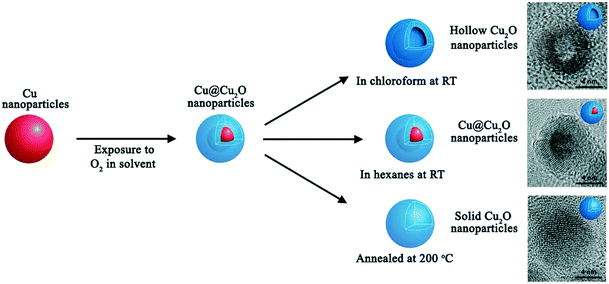 | ||
| Fig. 3 Oxidation of Cu nanoparticles to generate different monodisperse nanostructures. RT = room temperature. Reprinted with permission from ref. 83. Copyright Wiley-VCH 2010. | ||
 | ||
| Fig. 4 (a) A schematic illustration of the formation process of arrays of hierarchically 1D Cu2O nanotubes. Reprinted with permission from ref. 84. Copyright ACS 2009. | ||
Single shell. Zeng and coworkers have demonstrated that hollow Cu2O with polycrystalline single shells can be synthesized by the reduction of aggregated CuO nanocrystals.85 Typically, the hollow Cu2O products were prepared by using a mixture of Cu(NO3)2/N,N-dimethylformamide (DMF)/H2O under solvothermal conditions. The detailed formation process can be described as follows: (i) the synthesis of CuO nanoparticles; (ii) the aggregation of spherical CuO crystals; (iii) the reduction of CuO precursors to form spherical Cu2O; and (iv) the formation of hollow Cu2O spheres via the inside–out Ostwald ripening mechanism. A schematic of the formation process and color change in this case is shown in Fig. 5.85 Similarly, Su and coworkers have reported that hollow Cu2O microspheres with two active {111} and {110} facets have been synthesized in a Cu(NO3)2/ethylene glycol (EG)/H2O system through a fast solvothermal route in only 1 h at 180 °C.111 In this case, EG acted as a structure-directing reagent that can adsorb on the surface of the primary Cu2O nanoparticles and then direct the formation of a cross-linked polyhedron with two active {110} and {111} facets. Thus the formation mechanism can be attributed to a self-transformation process of the metastable nanoparticle aggregation accompanied by localized Ostwald ripening. Furthermore, poly(ethylene glycol 400) (PEG-400) molecules self-assemble to form micelles that can act as both a structure-directing and a reducing agent for the preparation of hollow Cu2O spheres with mesoporous single shells by a solvothermal approach.110
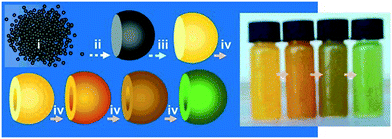 | ||
| Fig. 5 A schematic formation process and color change in the formation of hollow Cu2O spheres via the inside–out Ostwald ripening mechanism. Reprinted with permission from ref. 85. Copyright ACS 2005. | ||
The above solvothermal route for the synthesis of hollow Cu2O spheres involves a higher reaction temperature. Hence, it is necessary to develop a facile and fast synthetic strategy. Wang and coworkers have demonstrated that the Ostwald ripening of Cu2O can be generated at room temperature under ambient air through which solid Cu2O nanospheres were gradually evolved into thick nanoshells, thin nanoshells, and eventually collapsed shell structures over a time period of about 2 h (see Fig. 6a–f). In a typical synthesis, the hollow Cu2O spheres were formed in a mixture solution of Cu(NO3)2/polyvinylpyrrolidone (PVP)/hydrazine. PVP acted as a structure-directing agent to mediate the nuclei aggregation through its physical adsorption to form the solid spheres at the initial stage of the process. The detailed formation process can be described as follows: (i) the assembly of Cu2O nuclei to solid spherical aggregates by the reduction of Cu2+ ions by hydrazine; (ii) the interior cavities of the solid spheres through Ostwald ripening; (iii) the tailoring of the shell thickness by tuning the aging time. A schematic of shell evolution is illustrated in Fig. 6g, and it can be seen that the shell thickness continuously decreased as the Ostwald ripening continued until the shell structure began to collapse eventually.86 A similar Ostwald ripening of hollow Cu2O nanospheres has also occurred in Zhu and coworkers' work.109
| 2Cu2+ + N2H4 → 2Cu + N2 + 4H+ | (2) |
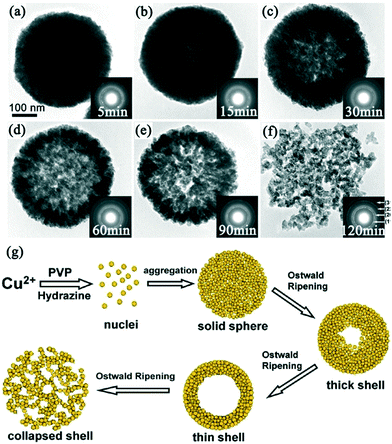 | ||
| Fig. 6 (a)–(f) The time-dependent formation of hollow Cu2O nanospheres with single shells based on the Oswald ripening mechanism. (g) A schematic of the shell-evolution process. Reprinted with permission from ref. 86. Copyright ACS 2011. | ||
A facile and surfactant-free gas bubble direct aggregation route has been employed to prepare hollow Cu2O spheres (see Fig. 7a and b) in a simple system of a mixture of CuSO4/hydrazine/H2O by Wang and coworkers.87 A schematic representation of the gas bubble assisted formation mechanism of hollow Cu2O spheres is shown in Fig. 7c. First, the Cu2+ ions were reduced by hydrazine to form Cu nanoparticles, which immediately evolved to Cu2O nanoparticles with oxidation by dissolved oxygen, as illustrated in step I. Then these Cu2O nanoparticles have a tendency to aggregate around the microbubbles of N2 gas produced in the reaction (see eqn (2) and step II). Finally, hollow Cu2O nanospheres aggregated from small nanoparticles were formed driven by the minimization of gas–liquid interfacial energies (step III). Accordingly, the idea of gas bubbles providing aggregation centers is a novel and effective strategy to synthesize hollow micro/nanospheres.
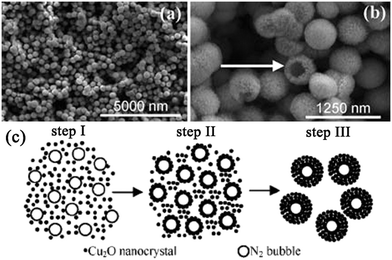 | ||
| Fig. 7 (a) and (b) SEM images of the hollow Cu2O nanospheres synthesized by a surfactant-free gas bubble direct aggregation route. (c) A schematic representation of the gas bubble assisted formation mechanism of Cu2O hollow spheres. Reprinted with permission from ref. 87. Copyright RSC 2010. | ||
Double shell. Based on Wang and coworkers' report on the synthesis of hollow Cu2O with a single shell,86 the authors have also developed a multistep Ostwald ripening approach for the preparation of shell-in-shell (double-shell) Cu2O.88 First, Cu2O single-layer nanoshells were obtained from the first step, the Ostwald ripening process,86 as schematically illustrated in Fig. 8a. However, it can be found that more Cu2O nanocrystallites were produced after the introduction of additional reactants into the reaction mixture and further assembled and packed new nanocrystals both inside and outside the first shell to form a thicker nanoshell (see Fig. 8b). Subsequently, a second Ostwald ripening process occurred; thus both the inner and the outer shells would gradually become thinner, resulting in the formation of double-layer nanoshell structures (see Fig. 8c and d). Interestingly, this multistep Ostwald ripening of hollow Cu2O spheres can be expanded by the addition of reactant in a different reaction stage, and it can also be effectively stopped once the particles were separated from the reaction mixture through centrifugation and re-dispersion in ethanol. Moreover, as a capping surfactant, cetyltrimethylammonium bromide (CTAB) can form self-assembled bilayers (multilayer) micelles, which act as soft templates to direct the synthesis of hollow Cu2O with a double shell. Wang and coworkers have developed a large-scale synthesis of double-shell Cu2O hollow spheres with the assistance of surfactant CTAB at room temperature.105 A typical synthesis process involves the reduction of a mixture of CuSO4/CTAB/H2O by using hydrazine, which is different from their previous gas-bubble-assisted synthesis of single-shell Cu2O hollow nanospheres.87 This synthesis mainly comprises two processes: (i) the formation of the single-shell Cu2O hollow spheres by the oxidation of Cu nanoparticles that were reduced from Cu2+ ions by hydrazine and (ii) the formation of the CTAB molecule layer strongly adsorbed on the surfaces of the single-shell Cu2O hollow spheres, resulting in the formation of double-shell Cu2O hollow spheres by a self-transformation process of the metastable aggregated small Cu2O particles accompanied by Ostwald ripening.
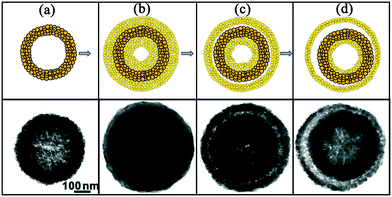 | ||
| Fig. 8 A multistep Ostwald ripening approach for tunable preparing Cu2O shell-in-shell (double-shell) hollow nanospheres. (a) Single-shell Cu2O hollow nanosphere; (b) multi-shell Cu2O hollow nanosphere; (c) Cu2O shell-in-shell structure with thick shell; (c) Cu2O shell-in-shell structure with thin shell. Reprinted with permission from ref. 88. Copyright ACS 2011. | ||
The template-free synthetic strategy has been attracting much attention for the synthesis of double-shell Cu2O hollow spheres. For example, Geng and coworkers have developed a template-free reduction reaction to prepare homogeneous Cu2O core–shell hollow nanostructures at room temperature without any surfactant. Typically, the reactants were only copper acetate (Cu(CH3COO)2) and ascorbic acid (AA); the Cu2O nucleation clusters were formed quickly and subsequently aggregated to form solid colloids through a general process of Ostwald ripening The resulting core–shell solid colloids have two parts with the same components, resulting in the formation of hollow Cu2O spheres with a double shell.106
Multi-shell. Although various hollow Cu2O spheres with multi-layer shells have been synthesized previously, the poly-crystalline structural shells generally possess some drawbacks, such as limiting electronic conductivity and mobility. Therefore, the integration of hollow and single-crystalline multi-shell/high-active facets in Cu2O crystals still remains a challenge.
As mentioned above, CTAB can form self-assembled micelles and bilayer (even multilayer) aggregates, including micelles, vesicles and multi-lamellar vesicles with increasing CTAB in aqueous solution. Inspired by this viewpoint, Wang and coworkers have further proved that a multi-lamellar vesicle assisted synthesis of multi-shell Cu2O hollow spheres can be achieved in a CuSO4/CTAB/AA/NaOH system at 60 °C, in which the attachment process was combined with Ostwald ripening to prepare multi-shell hollow structures with single-crystalline shells.89 The formation of different Cu2O hollow structures in the presence of a CTAB template is shown in Fig. 9a. The layers of the multi-lamellar vesicle acting as growth sites would lead to the formation of multi-shell hollow spheres, and the shell structures (single-, double- and triple-shelled, as shown in Fig. 9b and c) of these hollow Cu2O spheres can be controllably synthesized by adjusting the concentration of the CTAB. Based on the above synthesis, the authors have also found that the much smaller Cu2O nanoparticles first assembled into the well-crystallized porous shelled hollow spheres by oriented attachment, and subsequently the porous shells were further changed by Ostwald ripening to produce well-crystallized hollow spheres (see Fig. 10).90 In addition, various multiple-shell core–shell and yolk–shell nanostructures of (Cu2O@)n-Cu2O (n = 1–4) were prepared by a seed-mediated approach with successive Ostwald ripening; typical TEM images of various multiple-shell Cu2O hollow nanospheres are shown in Fig. 11a–d.91 The structure formed in a previous step can act as a former-generation seed for the subsequent shell growth; thus a total of 20 typical architectures have been produced by this step-by-step strategy (schematic shown in Fig. 11e),91 which is similar to that which occurred in Huang's work.72
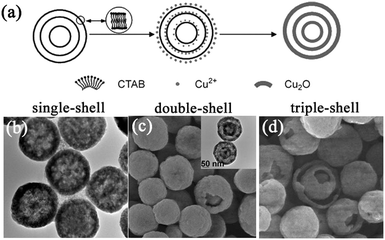 | ||
| Fig. 9 (a) A schematic of the formation process of hollow Cu2O structures with different shells in the presence of a CTAB template. (b) Single-shelled hollow cages. (c) Double-shelled hollow cages. (d) Triple-shelled hollow cages. Reprinted with permission from ref. 89. Copyright Wiley-VCH 2007. | ||
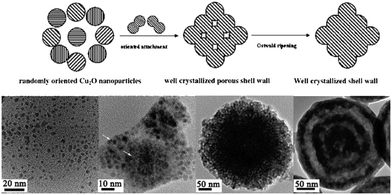 | ||
| Fig. 10 Schematic illustration of the time-dependent evolution of multi-shelled Cu2O hollow cages synthesized based on oriented attachment and Ostwald ripening mechanisms. Reprinted with permission from ref. 90. Copyright ACS 2008. | ||
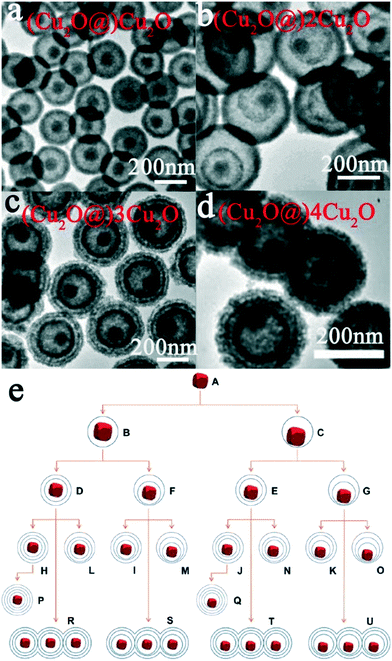 | ||
| Fig. 11 (a)–(d) TEM images of multiple-shell core–shell and yolk–shell nanostructures of (Cu2O@)n-Cu2O (n = 1–4). (e) 20 typical architectures produced in a step-by-step manner. Reprinted with permission from ref. 91. Copyright ACS 2012. | ||
A room-temperature CuCl-hydrolysis strategy has been proved to be facile for the synthesis of hollow Cu2O nanocubes, which was determined by the pH value of the medium solution and involved the absence of any reducers or surfactants. It has been demonstrated that the behavior of CuCl in aqueous solution was known to be pH sensitive; thus various products (such as HCuCl2, CuCl and Cu2O) can be obtained by increasing the pH value. Consequently, the transformation from CuCl to uniform hollow Cu2O nanocubes can be designed based on the chemical behavior of CuCl in water media with different pH values. First, the pH-controlled precipitation of CuCl at very low pH values (eqn (3)) was used to prepare uniform CuCl nanocubes. Next, the alkaline hydrolysis reaction from in situ CuCl nanocubes to hollow Cu2O nanocubes was generated based on the Kirkendall effect. According to the above-mentioned reaction mechanism, Du and coworkers have investigated the role of the pH value in the hydrolysis of dissolved CuCl precursor. In a typical synthesis, commercial CuCl powder (Fig. 12a) was first dissolved in a dilute HCl solution with a low pH value (Fig. 12b, pH <2.4). Then pure water was introduced to the solution to raise the pH value, leading to an immediate precipitation of uniform CuCl nanoparticles (pH >5.0). Finally, uniform CuCl nanocubes were formed (see Fig. 12c) and further served as self-sacrificial templates to prepare hollow Cu2O nanocubes (see Fig. 12e) through alkaline hydrolysis (see eqn (3)) along with further raising the pH value (see Fig. 12d).92
| 2CuCl + 2OH− → 2Cl− + Cu2O + H2O | (3) |
 | ||
| Fig. 12 A schematic illustration of the one-pot synthetic route from CuCl micro-powder to fine hollow Cu2O nanocubes with uniform sizes. (a) A schematic illustration of CuCl micro-powder; (b) a schematic illustration of HCuCl2 solution; (c) a schematic illustration of CuCl nanocube; (d) a schematic illustration of Cu2O hollow nanocube; (e) TEM images of Cu2O hollow nanocube. Reprinted with permission from ref. 92. Copyright RSC 2013. | ||
Similarly, Xie and coworkers have reported a surfactant-free synthesis of hollow Cu2O nanocubes by reducing Cu2+ precursors using Cl− ions as the shape-regulator at room temperature.93 Typically, hollow Cu2O nanocubes with an average length of 100 nm were synthesized in a mixture solution of Cu2+/NaCl/NaOH/ascorbic acid (AA). In this process, sufficient Cl− ions can be beneficial to prepare cubic CuCl self-sacrificial templates, resulting in the evolution into hollow Cu2O nanocubes. To further verify the CuCl-hydrolysis strategy for the synthesis of hollow Cu2O nanocubes, hollow Cu2O nanocubes can be synthesized when NaCl was replaced by NaBr, in which the crystal structure and chemical feature of CuBr was very similar to that of CuCl. Significantly, the authors have demonstrated that the formation mechanism of the as-prepared hollow Cu2O nanocubes was highly dependent on the amount of NaCl and NaOH in the reaction. When a small amount of NaOH was added into CuCl2 aqueous solution, a Cu2Cl(OH)3 precursor can be formed and subsequently evolve into cubic CuCl intermediates owing to the reduction of AA. Finally, hollow Cu2O nanocubes were successfully prepared through a hydrolysis reaction-induced Kirkendall process with CuCl nanocubes as self-sacrificial templates, and the reaction pathway is shown in Fig. 13a. However, solid Cu2O nanocubes were synthesized in a medium with a high concentration of NaOH and low concentration of Cl− ions because ascorbate was more easily oxidized under stronger alkaline conditions; thus higher reaction kinetics from Cu(OH)2 was achieved by the decreasing of CuCl precursors, finally resulting in the formation of solid-state products (see Fig. 13b).
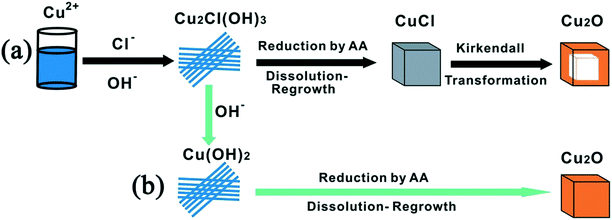 | ||
| Fig. 13 A schematic illustration of the synthesis of (a) hollow and (b) solid Cu2O nanocubes. Reprinted with permission from ref. 93. Copyright RSC 2013. | ||
Interestingly, Jiang and coworkers have found that slower reaction kinetics could be achieved when NaOH was replaced by weaker alkalinity LiOH (namely in a Cu2+/LiOH/L-ascorbic acid reaction system), which can weaken the oxidation of AA and might promote the formation of CuCl precursors. Thus the presence of Cl− ions would effectively control the oriented aggregation of primary Cu2O crystallites toward mesocrystalline Cu2O hollow nanocubes.99
From the above examples, it can be found that both the pH value (namely the concentration of H+ ions) and the concentration of Cl− ions were the key parameters for the construction of hollow Cu2O nanocubes. Therefore, balancing the hydrolysis and recrystallization rates of the CuCl precursors through precisely adjusting the experimental parameters (the concentration of the H+ and/or Cl− ions) was very crucial to the controllable synthesis of hollow Cu2O nanostructures. Based on this formation mechanism, Guo and coworkers have demonstrated a recrystallization-induced self-assembly for the preparation of hollow Cu2O superstructures.77 In the synthesis process, P123-decorated CuCl precursors were first synthesized in a mixture solution of CuCl2/NH3·H2O/P123/AA at room temperature. Afterwards, these CuCl precursors would transform into cube-like hollow Cu2O superstructures in another mixture solution of P123/KCl/AA/NH3·H2O. NH3·H2O was introduced to adjust the pH value and KCl was employed to adjust the [Cl−] concentration. P123 acted as a structure-directing agent for the oriented aggregation, which covered the surface of the CuCl precursors via the coordination of oxygen atoms in P123 to copper atoms in CuCl, preventing CuCl from undergoing rapid hydrolysis to build the hollow Cu2O superstructures. Hence, the development of a recrystallization-based process for the guided construction of 3D superstructures should further be explored, which might inspire us to synthesize new structures for expanding the practical applications.
A combination of oriented attachment with Ostwald ripening has been employed in the formation of hollow Cu2O nanocubes. For example, the synthesis of hollow Cu2O nanocubes through reductive self-assembly of CuO nanocrystals has been successfully achieved in a Cu(NO3)2/DMF/H2O system under hydrothermal conditions by Zeng and coworkers (see Fig. 14a and b).94 In this case, the Cu2+ ions can be controllably converted to oxide phases of CuO and Cu2O (see Fig. 14c). Instead of generating polycrystalline Cu2O nanospheres, primary CuO nanoparticles can undergo the “oriented attachment” mechanism to construct well-defined cubic shapes under a different set of process parameters, and then solid evacuation takes place in the central part of the shape-defined aggregates owing to Ostwald ripening, resulting in the formation of single-crystalline hollow Cu2O non-spherical (faceted) nanostructures (see Fig. 14d).
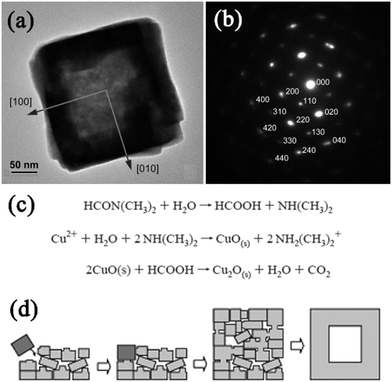 | ||
| Fig. 14 (a) TEM image and (b) selected area electronic diffraction (SAED) pattern of the hollow Cu2O nanocube synthesized reductive self-assembly of CuO nanocrystals. (c) The reaction equations. (d) A schematic illustration of the formation process. Reprinted with permission from ref. 94. Copyright ACS 2006. | ||
Additionally, in situ light-induced photochemical synthesis of Cu2O microcubes can be achieved by utilizing CuWO4 as the precursor.103 Typically, Cu2+ ions were first released from CuWO4 under a side irradiated photoreactor containing an aqueous solution of glucose and NaOH. Then, Cu2+ ions reacted with NaOH to form copper hydroxides. Subsequently, the copper hydroxides were further reduced by glucose to form hollow Cu2O cubes by a self-aggregation mechanism. Similarly, Zn-doped hollow Cu2O microcubes can also be synthesized using Zn-doped CuWO4 precursors under otherwise the same conditions.103 However, it remains a great challenge to develop feasible methods for the synthesis of doped Cu2O hollow structures.
Octahedral nanowire-assembled Cu2O superstructures can be prepared through a facile hydrothermal approach by reducing cupric acetate with o-anisidine or o-phenetidine in the presence of carboxylic acids at 180 °C, as shown in Fig. 15a and b.95 It can be seen that the products have polyhedral outlines and contain highly ordered nanowire subunits. The growth of the Cu2O nanowire polyhedra was tuned by the orientation and growth rates of the nanowire branches which can be adjusted by addition of carboxylic acid doped polymer chains. Additionally, concave octahedron and hexapod superstructures can be formed by further controlling the reaction parameters. Inspired by this synthesis pathway, reduced graphene oxide (rGO)-conjugated Cu2O nanowire mesocrystals were successfully synthesized by a non-classical crystallization mechanism in the presence of GO and o-anisidine under hydrothermal conditions, which displayed a higher sensitivity toward NO2 at room temperature.118
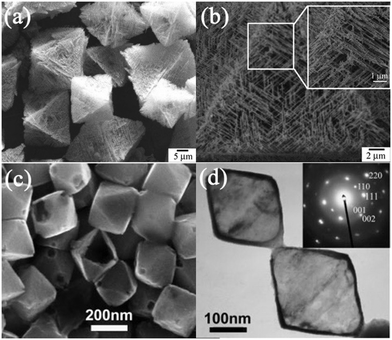 | ||
| Fig. 15 (a) and (b) SEM images of typical octahedral nanowire-assembled Cu2O superstructures. Reprinted with permission from ref. 95. Copyright Springer 2011. (c) and (d) TEM images of typical hollow octahedral Cu2O nanocages synthesized based on a catalytic solution route. Reprinted with permission from ref. 96. Copyright Wiley-VCH 2005. | ||
Moreover, typical hollow octahedral Cu2O nanocages can be synthesized by a self-catalytic etching strategy.96 Qi and coworkers have prepared hollow octahedral Cu2O nanocages with single-crystalline shells by reducing Fehling's solution (copper tartrate complex) with glucose at 75 °C in the presence of PdCl2 catalyst.96 Mechanistic investigation suggested that the formation of these octahedral Cu2O nanocages can be divided into the following two steps. (i) Octahedral solid nanocrystals were prepared by the Pd0-catalyzed reduction of the copper tartrate complex with glucose. (ii) The trace oxygen dissolved in solution would gradually oxidize Cu2O into Cu2+ in the presence of the Pd0 catalyst (oxygen-engaged oxidative etching, see eqn (1)). Finally, octahedral Cu2O nanocages with etching apexes were obtained after an aging process (see Fig. 15c and d).96 The selective oxidative etching on the apexes of the primary solid octahedral Cu2O nanoparticles might be attributed to the difference of the surface energies in different exposed facets.48 Based on the selective oxidative etching mechanism, it is believed that more novel hollow Cu2O micro/nanostructures might be facilely synthesized.
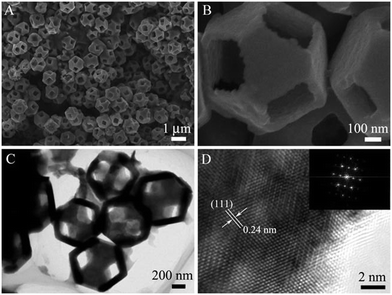 | ||
| Fig. 16 SEM (A and B) and TEM (C and D) images of the truncated octahedral Cu2O nanoframes composed of {111}-faceted skeletons and empty {100} facets. Reprinted with permission from ref. 97. Copyright Wiley-VCH 2010. | ||
Huang and coworkers have demonstrated a facile chemical etching route for the synthesis of truncated polyhedral Cu2O nanocages and nanoframes in an aqueous solution containing CuCl2, sodium dodecyl sulfate (SDS), NH2OH·HCl, HCl, and NaOH.102 The Cu2O nanostructures can be grown into nanoframes and nanocages by aging the reaction mixture under different reaction conditions, in which the introduction of HCl is crucial for promoting the etching process. Moreover, SDS may play a role in protecting the Cu2O nanocrystals from direct etching by HCl. A schematic illustration of the growth and etching mechanisms in the synthesis of the nanoframes and nanocages is shown in Fig. 17.98 Rapid seed-particle aggregation and surface reconstruction of the intermediate structure led to the formation of type I nanoframes, which have only {110} skeleton facets and empty {100} facets (see Fig. 18a–f),98 whereas selective acidic etching on the {110} facets of the nanocages through the addition of ethanol followed by sonication of the solution resulted in the formation of type II nanoframes (see Fig. 18g–l),98 which have elliptical pores on the {110} facets. Random etching of the nanocages can be obtained at a slow rate without addition of ethanol. Therefore, the strategy of oxidative etching combined with self-template of the precursors can be beneficial to the morphology-controllable synthesis of Cu2O with selective etching facets. However, the intrinsic feature of different crystallographic facets of Cu2O should attract attention in designing an etching hollow architecture. The anisotropic features on different facets will be thoroughly discussed in subsequent section 3.
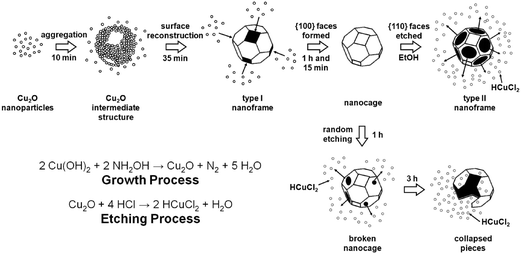 | ||
| Fig. 17 A schematic illustration of the growth and etching mechanisms in the synthesis of the nanoframes and nanocages. Reprinted with permission from ref. 98. Copyright ACS 2008. | ||
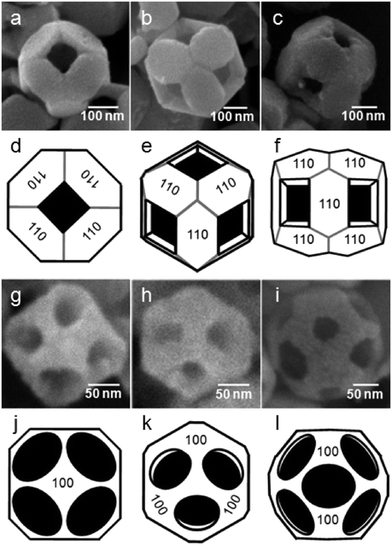 | ||
| Fig. 18 (a)–(f) TEM images and corresponding configurations of the type I Cu2O nanoframes with only {110} skeleton facets and empty {100} facets. (g)–(l) TEM images and corresponding configurations of the type II Cu2O nanoframes with elliptical pores on the {110} facets. Reprinted with permission from ref. 98. Copyright ACS 2008. | ||
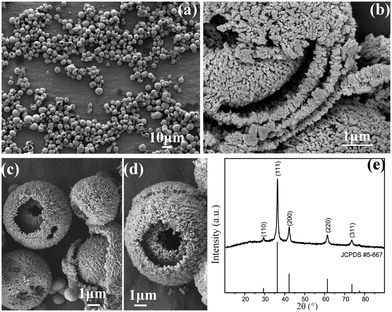 | ||
| Fig. 19 (a–d) SEM images with different magnifications and (e) XRD pattern of the Cu2O powder which was synthesized in an ethanol solution containing copper nitrate and glutamic acid after solvothermal treatment for 48 h. Reprinted with permission from ref. 107. Copyright Wiley-VCH 2007. | ||
Briefly, the formation of novel hollow Cu2O is expected to offer new opportunities to further explore the fundamental understanding as well as to enhance the practical applications. The synthesis methods, growth mechanisms and morphologies of the reported hollow Cu2O micro/nanostructures are summarized in Table 1. However, the development of simple synthetic strategies for controllably synthesizing uniform hollow Cu2O nanostructures wholly exposed with multi-index facets is still in its infancy.
| Precursor | Synthetic method | Mechanism | Morphology | Ref. |
|---|---|---|---|---|
| Copper(I) acetate/trioctylamine/tetradecylphosphonic acid | Oxidization of copper | Kirkendall effect | Hollow nanodots | 83 |
| Cu(OH)2/ascorbic acid | Liquid-phase reduction | Kirkendall effect | Hierarchical nanotubes | 84 |
| Cu foil/Cu(NO3)2/NH4Cl/KCl | Electrodeposition | Oxidative etching | Nanotube arrays | 112 |
| CuCl2/NaOH/CTAB/glucose/N2H4·H2O | Hydrothermal approach | Kirkendall effect | Nanotubes | 113 |
| CuSO4/CTAB/N2H4·H2O | Liquid-phase reduction | Ostwald ripening | Double-wall hollow spheres | 105 |
| Cu(CH3COO)2/ascorbic acid | Liquid-phase reduction | Ostwald ripening | Double-wall hollow spheres | 106 |
| Cu(NO3)2/glutamic acid/ethanol | Hydrothermal approach | Ostwald ripening | Multi-shell hollow spheres | 107 |
| Cu(NO3)2/DMF/water | Hydrothermal approach | Ostwald ripening | Single-shell hollow spheres | 85 |
| Cu(NO3)2/N2H4·H2O/PVP | Liquid-phase reduction | Ostwald ripening | Single-shell hollow spheres | 86 |
| CuSO4/N2H4·H2O | Liquid-phase reduction | Ostwald ripening | Single-shell hollow spheres | 87, 108 |
| Cu(NO3)2/N2H4·H2O | Liquid-phase reduction | Multistep Ostwald ripening | Shell-in-shell hollow spheres | 88 |
| CuSO4/CTAB/NaOH/ascorbic acid | Liquid-phase reduction | Ostwald ripening | Single-, binary-, triple- and quadruple-shell hollow spheres | 89 |
| CuSO4/CTAB/NaOH/ascorbic acid | Liquid-phase reduction | Ostwald ripening | Triple-shell hollow spheres | 90 |
| Cu2O/Cu(NO3)2/NH4NO3/NaOH/ascorbic acid | Liquid-phase reduction | Ostwald ripening | Core–shell and yolk–shell (Cu2O@)nCu2O (n = 1–4) | 91 |
| CuSO4/N2H4·H2O/PVP | Liquid-phase reduction | Ostwald ripening | Single-shell hollow spheres | 109 |
| Cu(NO3)2/ethylene glycol | Hydrothermal approach | None | Single-shell hollow spheres | 111 |
| CuSO4/PVP/sodium citrate/glucose | Liquid-phase reduction | Oxidative etching | Nanoframes with empty {100} facets | 97 |
| CuSO4/PVP/KOH/glucose/PdCl2 | Liquid-phase reduction | Oxidative etching | Hollow octahedron without {100} facets | 96 |
| CuCl2/NaOH/SDS/NH2OH·HCl/HCl | Liquid-phase reduction | Oxidative etching | Nanoframes with empty {110} and {100} facets | 98, 102 |
| CuCl/KCl/NH3·H2O | Hydrolysis of CuCl | Aggregation-based recrystallization | Hollow cubes | 77 |
| CuCl/HCl or NaOH | Hydrolysis of CuCl | Kirkendall effect | Hollow cubes | 92 |
| CuCl2/NaCl/NaOH/ascorbic acid | Liquid-phase reduction | Kirkendall effect | Hollow cubes | 93 |
| Cu(NO3)2/DMF/ethanol | Hydrothermal approach | Ostwald ripening | Hollow cubes | 94 |
| CuCl2/LiOH/ascorbic acid | Liquid-phase reduction | Oriented aggregation | Hollow cubes | 99 |
| CuCl2/NaOH/PEG-200 | Hydrothermal approach | Ostwald ripening | Hollow cubes | 101 |
| CuWO4/glucose | Liquid-phase reduction | None | Hollow cubes | 103 |
| CuSO4/ammonium citrate/glucose | Hydrothermal approach | Oxidative etching | Hollow octahedra | 115 |
| Copper nitrate solution | Spray pyrolysis approach | None | Hollow particles | 121 |
| Copper hydroxy nitrate/ethanol | Spray pyrolysis approach | None | Hollow particles | 122 |
2.2 Hollow CuO
It has also been found that the Kirkendall effect and Ostwald ripening as well as oriented attachment were generally used for the synthesis of hollow CuO.163,164 Hence, to overview the growth mechanisms and develop novel synthetic strategies are necessary for achieving the shape-tailored synthesis and expanding the potential applications. In this subsection, we will summarize the previous synthetic strategies and growth mechanisms of hollow CuO micro/nanostructures with different morphologies.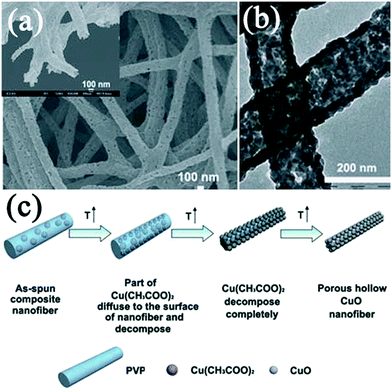 | ||
| Fig. 20 (a) SEM image and (b) TEM image of hollow CuO nanotubes synthesized by single-spinneret electrospinning of PVP/Cu(CH3COO)2 solution followed by annealing and reduction. (c) A possible formation mechanism of these porous CuO hollow nanotubes. Reprinted with permission from ref. 165. Copyright RSC 2011. | ||
To further improve the performance of CuO in practical applications, well-aligned CuO nanotube arrays with controllable diameters were synthesized using porous anodic alumina films (PAA) as templates. Typically, PAA templates were first prepared, and then the PAA was filled with a high concentration of cupric nitrate to form a mixture of PAA/cupric nitrate. Subsequently, the formation of PAA/CuO nanotubes was achieved by thermal decomposition of copper nitrate at 500 °C. Finally, CuO nanotube arrays were prepared by immersing the PAA/CuO nanotubes in sodium hydroxide solution to remove the PAA templates.166 Additionally, highly ordered hollow CuO nanotube arrays can be formed by the oxidization of Cu arrays through the Kirkendall effect.163,164
Tan and coworkers have developed a template-free method for preparing a hierarchically porous CuO hollow microsphere assembly with oriented 2D nanosheet subunits (see Fig. 21a–d) by mixing the CuSO4/KOH/NH3·H2O solution at 68 °C, which can be attributed to the direct transformation from [Cu(NH3)4]2+/Cu(OH)2 precursors to CuO primary nanocrystallites that occurred according to eqn (III) and/or eqn (IV) as shown in Fig. 21e.167 A two-step mechanism was proposed for the formation of these hierarchically porous CuO hollow microspheres. (i) The “oriented attachment” step, in which CuO nuclei was formed immediately and then a large number of primary CuO nanograins were produced. Subsequently, the fast oriented attachment of these CuO nanocrystals might lead to the formation of CuO nanosheet bundles driven by surface energy minimization. (ii) The “Ostwald ripening” step, in which the CuO crystallites located in the inner cores possessed relatively high surface energies possibly because of the defects of mismatch generated from the high growth rate at the early oriented attachment stage. Thus the unstable inner cores dissolved gradually along with prolonging the reaction time, finally resulting in the formation of hollow interiors in the CuO spheres.
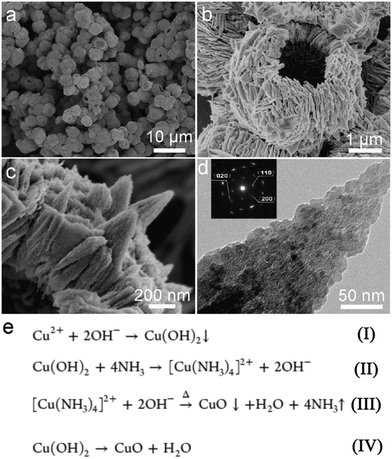 | ||
| Fig. 21 Hierarchically porous CuO hollow microsphere assembly by oriented nanosheet subunits. (a) A typical low-magnification SEM image; (b) a typical SEM image of an individual particle; (c) a high-magnification SEM image of the nanosheet subunits; (d) a typical TEM image of a nanosheet subunit, and the inset is the corresponding SAED pattern; (e) the corresponding chemical reaction equations. Reprinted with permission from ref. 167. Copyright ACS 2012. | ||
Similar hierarchical CuO hollow microspheres composed of 2D nanosheet subunits have also been synthesized by using CuSO4/organic solvent/H2O under a hydrothermal approach.168,169 Moreover, hierarchical CuO hollow microspheres assembled with nanorods have been synthesized by a template-free hydrothermal strategy based on the combined mechanism of oriented attachment and Ostwald ripening.169 Uniform CuO hollow microspheres were successfully achieved from non-uniform MOFs by using a template-free method, which can be attributed to aggregation and Ostwald ripening.170 In addition, a gas-bubble and/or droplet assisted strategy is also used for the synthesis of hollow CuO spheres with nanosized building blocks.171,172
| Cu2O + 1/2O2 + 2H2O + 8NH3 → 2[Cu(NH3)4]2+ + 4OH– | (4) |
| [Cu(NH3)4]2+ + 2OH– → Cu(OH)2 + 4NH3 | (5) |
| Cu(OH)2 + 2OH– → [Cu(OH)4]2– | (6) |
| [Cu(OH)4]2– → CuO + 2OH– + H2O | (7) |
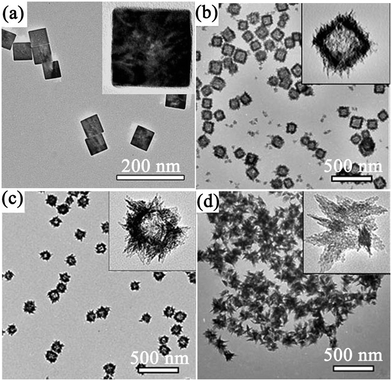 | ||
| Fig. 22 (a) TEM image of the Cu2O nanocubes. (b)–(d) TEM images of the hollow cubes, spheres and urchin-like CuO nanoparticles, respectively. Reprinted with permission from ref. 177. Copyright Wiley-VCH 2009. | ||
First, Cu2O was oxidized by oxygen molecules to produce a copper(II)–amine complex (reaction (4)) in an aqueous ammonia solution. The copper(II) amine slowly evolved to divalent copper hydroxide (Cu(OH)2) in the solution-phase system (reaction (5)), whereas the tetrahydroxo-cuprate(II) anion [Cu(OH)4]2− would be generated from the copper hydroxide under a strong basic environment (reaction (6)) because of the Jahn–Teller stabilization in square-planar copper(II) complexes.241 Finally, thermodynamically stable CuO was produced by the decomposition of [Cu(OH)4]2− species (reaction (7)) due to its low solubility in water. From the above reactions, it can be proposed that a high ammonia concentration would result in the fast dissolution of Cu2O as in reaction (4), and thus the hydroxide ion concentration also increased the total reaction rates through reactions (5) and (6). However, the [Cu(OH)4]2− species were highly stable at high OH− concentrations, which can decrease the precipitation rate of CuO through the reverse process of reaction (7). Therefore, various CuO nanostructures (such as hollow cubes, spheres and urchin-like nanoparticles, see Fig. 22b–d) were finally synthesized by the introduction of different NaOH concentrations.
Based on the intrinsic principles of the above synthesis, Yang and coworkers have synthesized 26-facet hollow CuO microstructures by a modified approach, as shown in Fig. 23a. The formation of the hollow CuO 26-facet polyhedron can be attributed to the Kirkendall effect. In this case, a CuO shell was initially formed on the surface of Cu2O. Subsequently, the oxygen and ammonia in the solution diffused inward, while the Cu+ in the Cu2O core diffused outward. The different diffusion rates resulted in the hollow structure.179 Notably, it is proposed that different CuO micro/nanocages can be easily prepared by full oxidation of the morphologically hollow Cu2O cages (as discussed in section 2.1).
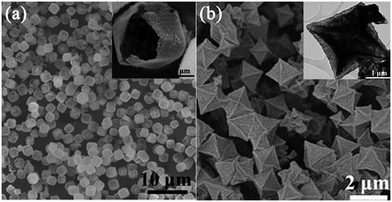 | ||
| Fig. 23 (a) 26-facet hollow CuO microstructures synthesized by a modified Cu2O-templated approach. Reprinted with permission from ref. 179. Copyright RSC 2014. (b) Octahedral hollow CuO microstructures synthesized by a MOF-templated approach. Reprinted with permission from ref. 180. Copyright RSC 2013. | ||
MOFs acting as sacrificial templates can also be employed to prepare the hollow CuO architectures because the metal ions or clusters of MOFs can evolve into metal oxide through a proper thermal treatment process. Huang and coworkers have reported a simple and scalable synthesis of porous CuO hollow octahedra by annealing the [Cu3(btc)2] (Cu-btc, btc = benzene-1,3,5-tricarboxylate) MOF templates at 300 °C (see Fig. 23b).180 The synthesis strategies and morphologies of the reported hollow CuO micro/nanostructures are summarized in Table 2.
| Precursor | Synthetic method | Mechanism | Morphology | Ref. |
|---|---|---|---|---|
| Cu nanowire arrays | Thermal annealing | Kirkendall effect | Nanotube arrays | 163, 164 |
| Cu(CH3COO)2/PVP | Electrospinning + annealing | None | Hollow nanofibers | 165 |
| Cu(NO3)2/PAA | Electrodeposition | Alumina template | Nanotubes | 166 |
| CuSO4/KOH/NH3·H2O | Liquid-phase hydrolysis | Oriented attachment and Ostwald ripening | Hierarchically hollow spheres | 167 |
| Cu(CH3COO)2/EG/H2O | Hydrothermal approach | Self-assembly | Hierarchically hollow spheres | 168 |
| Cu(CH3COO)2/urea/H2O | Hydrothermal approach + annealing | Self-assembly | Hierarchically hollow spheres | 169 |
| Cu(NO3)2/benzene-1,3,5-tricarboxylic acid/DMF/EtOH/H2O | Thermal annealing | MOF template | Hierarchically hollow spheres | 170 |
| Cu(NO3)2/sucrose/hydrogen peroxide | Spray pyrolysis method | None | Hollow spheres | 171 |
| CuSO4/NH3·H2O/tyrosine | Hydrothermal approach | Self-organization | Hierarchically hollow spheres | 173 |
| CuCl2/NaOH/carbon | Thermal annealing | Carbon sphere template | Hollow spheres | 174 |
| Cu(HCOO)2/sodium alginate/NH3·H2O | Hydrothermal approach | None | Hollow spheres | 175 |
| CuSO4/glutamine | Hydrothermal approach | None | Hierarchically hollow spheres | 176 |
| Cu2O/NaOH/ethanol/H2O | Liquid-phase reaction | Kirkendall effect | Hierarchically hollow cubes, spheres and urchins | 177, 178 |
| Cu2O/NaOH/ethanol/H2O/glucose | Liquid-phase reaction | Kirkendall effect | Hierarchically hollow polyhedra | 179 |
| [Cu3(btc)2] | Thermal annealing | None | Hierarchically hollow octahedra | 180 |
| Cu(HCOO)2/hexylamine/ethyl cellulose/1-methyl-2-pyrrolidinone | Thermal annealing | Kirkendall effect | Hollow spheres | 231 |
3. Interfacial Cu–O atomic structures and their intrinsic properties
As a cuprite structure, Cu2O is a cubic close packing of Cu atoms, with O atoms in tetrahedral sites at positions (3/4, 3/4, 3/4) and (1/4, 1/4, 1/4) of the cubic lattice, in which the coordination of the Cu atoms is half that of the O atoms (see Fig. 24a).160 Consequently, Cu atoms in the bulk crystal are twofold coordinated by O atoms; each O atom is surrounded by a tetrahedron of Cu atoms, and each Cu atom has two O atom neighbors, as described by its unit cell model. Meanwhile, the CuO crystal is a monoclinic structure with two molecules per primitive cell (see Fig. 24b) where each Cu atom is surrounded by four O atoms.160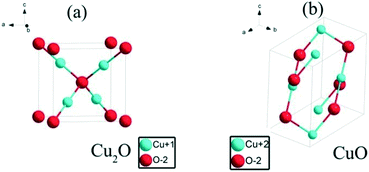 | ||
| Fig. 24 Crystallographic structures of the Cu2O lattice (a) and the CuO lattice (b). Reprinted with permission from ref. 160. Copyright RSC 2013. | ||
When the Cu–O bonds of Cu2O encounter O molecules, the O atoms insert the lattice of the Cu2O unit cell through different atom rearrangements and reconstructions of the lattice/unit cell; thus the monoclinic unit cell of CuO is formed at a higher temperature, finally resulting in the synthesis of a Cu2O–CuO heterogeneous interface. While the Cu–O bonds of Cu2O encounter a specific reducer, the O atoms are released from the Cu2O unit cells, leading to the formation of Cu species on their surfaces, and thus a Cu2O–Cu heterogeneous interface is formed.
Briefly, the construction of Cu2O–CuO and Cu2O–Cu heterogeneous architectures is beneficial to the investigation of the intrinsic properties of interfacial Cu–O atomic structures, which can be used to direct the design and synthesis of hybrid CuxO micro/nanostructures for expanding their potential applications. In this section, we will mainly discuss the intrinsic properties of different interfacial Cu–O atomic structures and then summarize the advancements in controllable synthesis of hybrid CuxO micro/nanostructures (including hollow Cu2O–CuO and Cu2O–Cu).
3.1 Intrinsic properties of interfacial Cu–O atomic structures
In general, surface Cu atoms of Cu2O are coordinatively unsaturated, resulting in the intrinsic surface atomic structures being different.14,15,61 For example, both Cu and O atoms predominate in the {111} and {110} facets of Cu2O, and surface Cu atoms with dangling bonds can make them positively charged. The {110} facets contain rows of twofold-coordinated Cu atoms and onefold-coordinated Cu atoms with one dangling bond perpendicular to the surface, and the same terminated Cu atoms with dangling bonds are existing in the {111} facet, but the distance between two the Cu atoms is about twice that in the {110} facet, suggesting that the number and density of Cu dangling bonds in the {111} facets are lower than those of the {110} facets.61 In addition, the {100} facet is constituted by Cu or O atoms only, and thus the Cu atoms on the {100} surface are in saturated coordination, resulting in an electrically neutral state.61 Hence, new Cu–O interfaces generated from various Cu2O surfaces will lead to the difference in their intrinsic properties and thus the underlying intrinsic principle of interfacial Cu–O atomic structures is significant to develop novel hybridizing architectures with improved performances.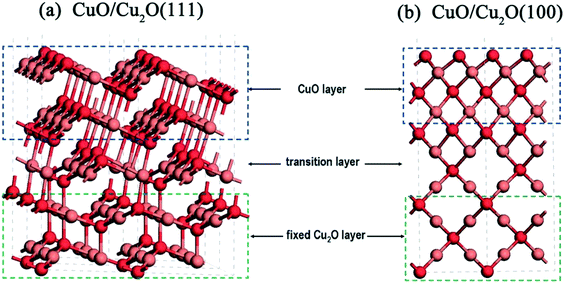 | ||
| Fig. 25 The interfacial Cu–O atomic structures of Cu2O{111} and Cu2O{100} facets. Reprinted with permission from ref. 181. Copyright Wiley-VCH 2011. | ||
Moreover, the formation of the Cu2O–CuO heterogeneous interface can promote the spatial charge carrier (electrons and holes) separation and suppress charge recombination. As an example of a photocatalyst, the Cu2O–CuO heterojunction is in agreement with the type II mechanism. Under solar-light irradiation, the photogenerated electrons from Cu2O with a higher conduction band (CB) edge can migrate to CuO with a lower CB edge. Furthermore, the photogenerated holes from CuO with a lower valence band (VB) edge will be transported to Cu2O with a higher VB edge. Thus, the hybrid Cu2O–CuO heterogeneous catalysts can exhibit an enhanced photocatalytic performance compared to the single-component ones.242
Therefore, the construction of highly active Cu–O atomic structures on Cu2O surfaces in reactive environments (namely anisotropic surface restructuring) would open a new door for optimizing and designing efficient catalysts.
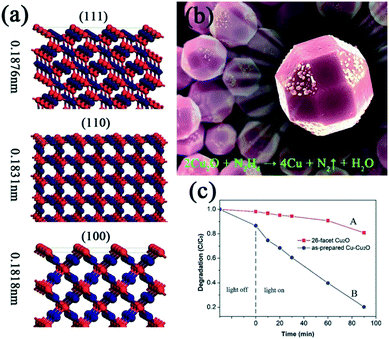 | ||
| Fig. 26 (a) DFT calculations of the surface structures of {111}, {110} and {100}. (b) SEM image of the Cu–Cu2O synthesized by an in situ reduction route. (c) Photodegradation curves of Cu–Cu2O and pristine Cu2O. Reprinted with permission from ref. 182. Copyright RSC 2012. | ||
3.2 Synthesis of interfacial Cu–O atomic structures
As discussed above, the construction of different interfacial Cu–O atomic structures can effectively develop novel CuxO micro/nanostructures with improved performances. In this subsection, we will highlight the advances in controllable synthesis of hybrid CuxO micro/nanostructures, including hollow Cu2O–CuO and Cu2O–Cu.| 2Cu2O + O2 + 4H2O → 4Cu(OH)2 | (8) |
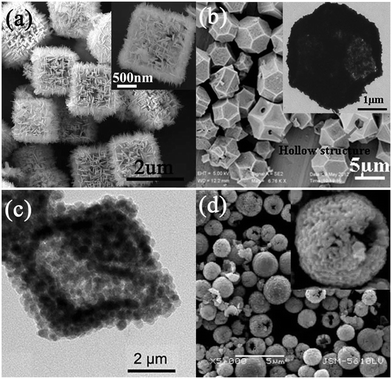 | ||
| Fig. 27 (a) Uniform Cu2O–CuO microcubes prepared by oxidation etching of Cu2O microcubes under hydrothermal conditions. Reprinted with permission from ref. 183. Copyright RSC 2013. (b) Hollow Cu2O–CuO truncated octahedral microstructures synthesized by annealing of the truncated octahedral [Cu3(btc)2]n. Reprinted with permission from ref. 184. Copyright RSC 2013. (c) Hollow Cu2O–CuO octahedral microstructure assembly of many nanoparticles prepared by annealing of the octahedral [Cu3(btc)2]n. Reprinted with permission from ref. 185. Copyright RSC 2015. (d) Hollow Cu2O–CuO microspheres synthesized by template-free hydrothermal treatment of copper precursors. Reprinted with permission from ref. 186. Copyright ACS 2007. | ||
Although it is a general strategy for preparing uniform hollow cages of metal hydroxides by coordinating etching of Cu2O templates at room temperature and then obtaining hollow metal oxide cages by simple thermal treatment of the as-prepared metal hydroxides, it is not ensured that hollow CuO or Cu2O–CuO cages can be synthesized by this approach.244
In order to obtain hybrid Cu2O–CuO nanostructures with high specific surface areas, a MOF-templated strategy is useful to achieve this purpose. For example, hollow Cu2O–CuO truncated octahedral microstructures with porous shells can be synthesized by thermal decomposition of the coordination compound [Cu3(btc)2]n (see Fig. 27b).184 Furthermore, a hollow Cu2O–CuO octahedral microstructure assembly of many nanoparticles was also prepared by annealing of the octahedral [Cu3(btc)2]n (see Fig. 27c).185 However, there is still much room for progress with regard to the development of new hollow Cu2O–CuO cages based on this method. Additionally, a template-free hydrothermal treatment of copper precursors can be used to synthesize hollow Cu2O–CuO microspheres (see Fig. 27d).186
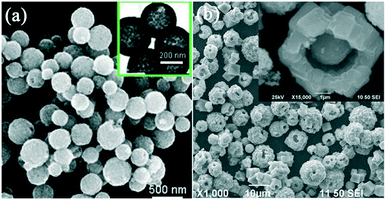 | ||
| Fig. 28 (a) Hybrid Cu2O–Cu hollow spheres fabricated by a microwave-assisted hydrothermal method. Reprinted with permission from ref. 248. Copyright RSC 2015. (b) Hollow Cu2O–Cu synthesized by solvothermal reduction of copper(II) precursors. Reprinted with permission from ref. 249. Copyright RSC 2012. | ||
4. Applications
The synthesis of hollow CuxO micro/nanostructures with high porosities, uniform and well-defined morphologies, and mono-dispersed sizes would expand their potential applications, which can be attributed to higher specific surface areas and surface activities. Furthermore, the optimization of interfacial Cu–O atomic structures of hybrid CuxO can further offer a new pathway to improve their performances. Additionally, thin shells and hollow interiors can decrease the diffusion path lengths relative to conventional bulk ones. Consequently, the enhanced performances of hollow CuxO micro/nanostructures can afford many potential opportunities for their application in the fields of catalysis and sensing and as lithium-ion battery anode materials. In this section, we will review the detailed applications of hollow CuxO micro/nanostructures (including Cu2O, CuO, Cu2O–CuO as well as Cu2O–Cu) in the above mentioned fields.4.1 Catalysts
Mesopores in hollow photocatalysts can bring about larger specific surface areas and accelerate the adsorption of pollutants onto the catalysts, and shorten the diffusion path of free photogenerated charge carriers from the bulk phase to the surface, thereby increasing the separation efficiency of photogenerated charge carriers.95,115 For example, a hollow Cu2O octahedral assembly of nanowire building blocks (as shown in Fig. 15a and b) could display improved photocatalytic activities for dye degradation under visible light compared with the solid ones, probably because of the high-density photogenerated charge carriers from the branched nanowires with their special structures.95 Notably, Cu2O has been found to possess a much stronger adsorption ability for methyl orange (MO) than for methylene blue (MB), since MO experienced a greater decrease in absorption intensity with respect to that of MB under the same conditions after the adsorption–desorption equilibrium was reached. Hence, the rapid dynamic process of the adsorption of MB and the desorption of its oxidized form can partially be attributed to the higher rate of MB degradation compared with that of MO (see Fig. 29a and b).
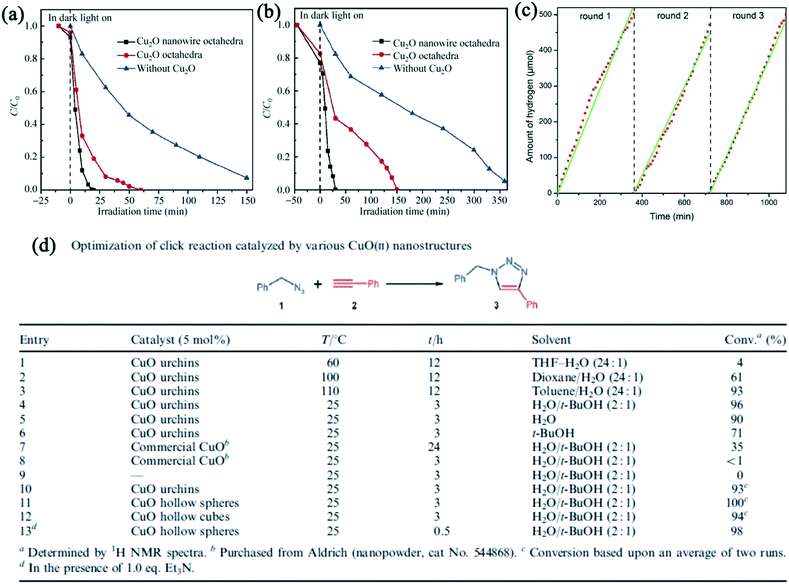 | ||
| Fig. 29 Plots of concentration percentage of (a) MB and (b) MO in an aqueous solution against irradiation time in the presence or absence of Cu2O photocatalyst samples. Reprinted with permission from ref. 95. Copyright Springer 2011. (c) Photocatalytic hydrogen production under visible light irradiation over Zn-doped Cu2O. Reprinted with permission from ref. 103. Copyright ACS 2014. (d) Optimization of click reaction catalyzed by various CuO(II) nanostructures. Reprinted with permission from ref. 178. Copyright RSC 2010. | ||
As reported, the {111} facets of Cu2O possess surface copper atoms with dangling bonds, so that the {111} facets are higher in surface energy and expected to be more photocatalytically active than the {100} facets.61 As for a truncated octahedral architecture, the presence of more {111} facets can contribute to more efficient photocatalysis. However, a truncated octahedral Cu2O is generally enclosed by 6 {100} and 8 {111} facets; the low-activity {100} facets would limit the wholly catalytic activity. A hollow Cu2O truncated octahedral nanoframe composed of 8 {111} facets but without {100} facets (as shown in Fig. 16) is a typical example for achieving the construction of a catalyst with useful and active exposed surfaces. The photocatalytic degradation of the rhodamine B (RhB) activity of this hollow particle was higher than that of the solid particles, which can be attributed to the hollow structure with a larger surface area, because the hollow structure can allow multiple reflections of light within the interior and result in more efficient use of light and enhanced photocatalytic activity.97 Similarly, the hollow CuO nanospheres with higher surface areas also exhibited superior photocatalytic degradation activities than the solid ones.175
Remarkably, the optical responses of hollow Cu2O with controllable nanoshells can be fine-tailored in the visible spectral region by tuning the inner and outer radii of the spherically symmetric nanoshells, which was believed to be important to the optimization of Cu2O-based photonic devices for photovoltaic and photocatalytic applications.86,88 Therefore, it is necessary to carry out the synthesis/modification of hollow Cu2O with fine-tuned shells. Briefly, hollow CuxO structures can effectively shorten the distance as well as the time for charge carrier transfer from the bulk to the surface and increase the specific surface areas to enhance the active sites to optimize the photocatalytic performances.
4.2 Sensing
For example, ethanol molecules can be adsorbed on the surface of hollow CuxO micro/nanostructures at higher reducing gas temperature, and then the injected electrons from ethanol molecules neutralized the holes and decreased the carrier density in the surface charge layer of the hollow CuxO micro/nanostructures. Thus, the adsorption of ethanol molecules would cause a marked increase of the resistance of CuxO sensors. Therefore, the surface accessibility and shell thinness are significant to keep the high sensitivity for the hollow architecture. Typically, the hierarchical Cu2O microspheres with hollow and multilayered configuration are very suitable to sensing for ethanol molecules.107 Similarly, hierarchical CuO microspheres with controllable building blocks also show suitable performances for the application in gas sensing. For instance, hierarchically porous CuO hollow spheres (see Fig. 20) can display an excellent sensing activity toward H2S, such as low detection limit of 2 ppb, high sensitivity at parts per billion level concentration, broad linear range, short response time of 3 s, and recovery time of 9 s. The excellent performance was due to the unique hierarchically hollow architecture: the quasi-micropores provided active sites for effective sensing, the mesopores promoted the molecular diffusion kinetics, and the macropores acted as gas reservoirs and minimized diffusion length, while the good conductivity of the quasi-single-crystal nanosheet building blocks can be beneficial to fast charge transportation, finally leading to the high sensitivity, quick response and recovery of the H2S gas (see Fig. 30a).167
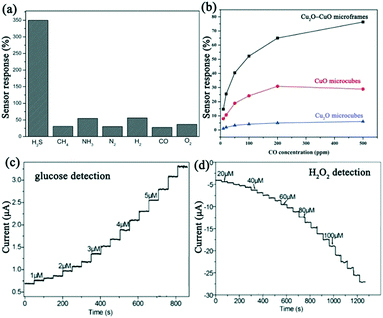 | ||
| Fig. 30 (a) Sensor responses obtained for the hierarchically porous CuO spheres at the working temperature toward 1 ppm H2S and 100 ppm CH4, NH3, N2, H2, CO, and O2. Reprinted with permission from ref. 167. Copyright ACS 2012. (b) The calibration curves of the sensor response versus CO concentration at the working temperature of 240 °C when using the Cu2O–CuO microframes, the CuO microcubes and the Cu2O microcubes. Reprinted with permission from ref. 183. Copyright RSC 2013. (c) Amperometric responses upon successive injections of glucose to 0.1 M NaOH at the mesocrystalline Cu2O hollow nanocube modified glass carbon electrode. (d) Amperometric responses at the mesocrystalline Cu2O hollow nanocube modified glass carbon electrode upon the periodic addition of H2O2 to 0.1 M PBS (pH 7.0) at −0.3 V. Reprinted with permission from ref. 99. Copyright RSC 2012. | ||
As expected, the modification of interfacial Cu–O atomic structures toward hollow CuxO micro/nanostructures can be an effective strategy for improving the gas sensing performance. For example, the cubic Cu2O–CuO hollow microframes (see Fig. 26a) exhibited enhanced gas sensing activities towards CO with a lower detection limit, higher sensitivity and shorter response time than those of the pure CuO microcubes and Cu2O microcubes at the working temperature of 240 °C (see Fig. 30b), which was possibly attributed to the additional depletion layer formed between CuO and Cu2O as well as the structural advantages of the hollow microframes.183 The heterogeneous Cu2O–Cu hollow spheres with a large amount of macropores and mesopores (see Fig. 27a) can offer sufficient space for the interaction between the spheres and the test gas, which was similar to that occurring in the above hierarchical porous hollow architectures.254 When the metal Cu came into contact with the semiconductor Cu2O at thermal equilibrium, the electrons flowed from Cu to Cu2O until the Fermi levels aligned at equilibrium because of their different work functions, which can lead to an excess of negative charge on the Cu2O surface and the formation of a positive charge depletion zone in Cu near its surface. The depletion zone can promote the diffusion of holes from the Cu2O to the Cu, which can be favorable to the oxidation of the NO2 gas. In addition, the negative charges on the Cu2O surface could facilely react with NO2, resulting in the formation of adsorbed NO2− and O−. Therefore, these reactions can decrease the electron concentration on the surface of Cu2O and increase the hole conductivity in the Cu2O semiconductor, which lead to a decrease of the resistance. This would benefit the fast adsorption and diffusion of NO2 molecules and result in effective sensing properties.248
As for hollow Cu2O, the multi-shell hollow Cu2O nanospheres with fine-tuned shells also possessed enhanced sensitivity and activity for non-enzymatic glucose sensing.91 The mesocrystalline Cu2O hollow nanocubes can display high electrocatalytic activities for non-enzymatic amperometric detection of hydrogen peroxide and glucose (see Fig. 30c and d).99 The double-shell Cu2O hollow nanospheres exhibited high efficiency and convenience toward the detection of dopamine.106 As for hollow CuO, the hollow CuO polyhedral 26-facet architectures exhibited high sensitivity, low detection limit, good stability and fast response towards the non-enzymatic oxidation of glucose.179 Hierarchical hollow mesoporous CuO microspheres showed an excellent recyclable catalytic activity for the decomposition of hydrogen peroxide, and the catalytic efficiency was improved with the increasing special surface areas of the hollow microspheres.169 However, the inherent conductivity of the CuxO semiconductor is not very good, which is unfavorable for charge separation and transfer and might affect the electrochemical performances for biosensors. Hybrid Cu2O–Cu hollow spheres with conductive Cu composites can effectively improve the electrochemical performances toward the non-enzymatic oxidation of glucose,249 in which the intrinsic principle for enhanced performance might be similar to that occurring in a previous reference.248
So far, the interfacial chemistry of the Cu–O system on sensing properties is still controversial and further study is imperative. The design and synthesis of new hybrid CuxO-based hollow micro/nanostructures is necessary.
4.3 Anode material for lithium-ion battery
The use of CuO as electrode materials for rechargeable lithium-ion batteries (LIBs) has been intensively investigated due to its high theoretical capacity (670 mA h g−1), high level of safety, non-toxicity and low cost. However, the large volume variation during the lithium uptake/release process and low conductivity will result in severe mechanical strains and very rapid capacity decay during the cycling process. Hence, to overcome such drawbacks and enhance the electrochemical performances, great effort has been made to develop hollow structural electrodes with outstanding performances and having properties such as shorter ion diffusion and larger contact areas between the electrode and the electrolyte compared to their bulk companions.Currently, hierarchically hollow CuO nanostructures have been considered as promising candidates because of their high surface-to-volume ratio and the synergistic effect between the nanoscale building blocks and the porous pathways, which not only can keep the high activity of the CuO materials, but also offer an effective structure to relieve the volume variation during Li+ uptake/removal. For example, the urchin-like CuO nanoparticles can maintain a charge capacity above 560 mA h g−1 at a current density of 150 mA g−1 for up to 50 cycles (see Fig. 31a).177 Pompon-like hierarchical CuO hollow microspheres assembled from porous nanorods exhibited excellent performance as anodes for LIBs, which can deliver a capacity of 683.7 mA h g−1 at a current density of 67 mA g−1 after 50 charge–discharge cycles (see Fig. 31b).176
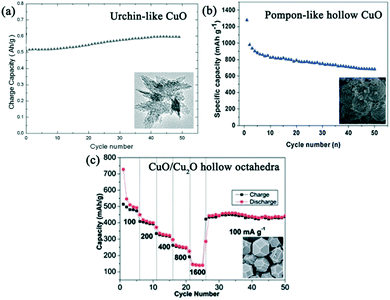 | ||
| Fig. 31 Cycling performance of the (a) urchin-like CuO, (b) pompon-like hollow CuO and (c) CuO/Cu2O hollow polyhedron, respectively. Reprinted with permission from ref. 177. Copyright Wiley-VCH 2009. Reprinted with permission from ref. 176. Copyright RSC 2014. Reprinted with permission from ref. 184. Copyright RSC 2013. | ||
Binary-component CuO–Cu2O often integrates two types of functional materials that can display a strong synergistic effect, which will improve the intrinsic properties of each component such as electrical/ionic conductivity, electrochemical reactivity, and mechanical stability.186,255 For example, hollow polyhedral Cu2O–CuO with porous shells exhibited a reversible lithium storage capacity as high as 740 mA h g−1 at a current density of 100 mA g−1 after 250 cycles even if the charge–discharge process was stopped for one week during the test time (see Fig. 31c).184 The superior capacity might be attributed to the particular micro/nanostructures of hollow Cu2O–CuO polyhedra as follows. First, the porous shells were convenient for the intercalation of Li+ ions into the active species and accelerating their diffusion velocity. Second, the hollow structures gave structural integrity with enough void spaces for buffering the volume variation during the redox reaction, thus alleviating the pulverization problem and achieving a long cycling life. Third, the hierarchical micro/nanostructures could reduce side reactions with the electrolyte, ensuring excellent electrical properties. Finally, as discussed in previous reports, the synergistic effect between the CuO and Cu2O components can also be beneficial to the high capacity.
Based on the above discussion, it can be highlighted that hollow Cu2O is a promising candidate for application in the fields of photocatalysis and sensing, while hollow CuO is widely used in the fields of organic synthesis catalysis and sensing and as anode material for LIBs.
5. Conclusion and perspectives
In summary, various kinds of hollow CuxO micro/nanostructures have been investigated and applied in the fields of photocatalysis and sensing and as LIBs owing to the large specific surface area and surface activity, the special morphology (thin shells and hollow interior), superior charge/mass transport and high permeability. The intrinsic property of the interfacial Cu–O atomic structure has also become an attractive field in CuxO-based studies in the past years. In this review, a comprehensive summary of the universal synthesis strategies and formation mechanisms, the interfacial Cu–O atomic structures as well as intrinsic properties, and their potential applications, have been specially demonstrated for different types of hollow CuxO micro/nanostructures. The recent advances in the controllable synthesis of hollow CuxO micro/nanostructures offer a good opportunity for designing and constructing high-performance architectures by fine-controlling the shell structures as well as the surface atomic/or interfacial properties.In regard to the synthesis of new hollow CuxO micro/nanostructures, a significant task is to rationally design and tune the morphologies, surface atomic arrangements and intrinsic atomic/electronic structures. As reported, a facet-dependent property, especially introducing more high-activity exposed facets, could provide a top priority for improving the catalytic performances of inorganic crystals.14–16 However, it has rarely been considered for the hollow CuxO micro/nanostructures with facet-dependent performances. Consequently, more efforts should be employed to facilely synthesize novel hollow CuxO micro/nanostructures with facet-dependent properties to uncover the relationship between intrinsic surface atomic structures and catalytic performances. In addition, using metal and/or nonmetal-doped copper precursors might be an effective way for designing and achieving the synthesis of hollow doped-CuxO micro/nanostructures. Notably, the stability of interfaces and the photo-corrosion of Cu2O photocatalysts should be optimized and avoided. An appropriate protective layer coating on hollow Cu2O micro/nanostructures is an effective approach for overcoming these drawbacks. Furthermore, light-induced photochemical synthesis of hollow Cu2O micro/nanostructures is worth further developing, in which the as-synthesized Cu2O would withstand photocorrosion in a kinetically more favorable way to improve the stability.
The application of hollow CuxO micro/nanostructures as hard templates or nanoreactors for preparing other hollow inorganic nanoparticles should be highlighted. In addition, hybrid hollow CuxO templates combined with a new template-based synthetic approach can provide a good idea to obtain a broad range of novel binary and ternary heterogeneous architectures, which would further enrich the template-synthesis of hybrid copper-based hollow nanostructures.
Concerning the modifications on the intrinsic properties of interfacial Cu–O atomic structures, in situ hybridizing (such as the oxidization or reduction of CuxO) is an effective strategy. Illuminating the interface-dependent intrinsic property to substantially optimize the potential performance is imperative. Selective hybridizing of active species to specific facets of hollow CuxO micro/nanostructures should attract intensive attention. Significantly, doped CuxO hollow micro/nanostructures with novel electronic structures acting as supports are promising for preparing highly effective architectures, but it is still in its infancy.
Briefly, the comprehensive and in-depth highlight on the universal synthesis strategies and formation mechanisms, the interfacial Cu–O atomic structures as well as intrinsic properties, and their potential applications, will promote the development of novel function-oriented CuxO-based hollow micro/nanostructures.
Conflicts of interest
There are no conflicts to declare.Acknowledgements
This work was supported by the National Science Foundation of China (NSFC No. U1502274, 51302213, 51272209, 51471132 and 51202191), the National High Technology Research and Development Program of China (863 Program, No. 2015AA034304), the Pivot Innovation Team of Shaanxi Electric Materials and Infiltration Technique (2012KCT-25), the Hundred Talent Program of Shaanxi Province, the Science Foundation of Jiangsu Province of China (No. BK20161250), and the Zhejiang Public Welfare Technology Research Industry Project (No. 2016C31G4181807).Notes and references
- X. W. Lou, L. A. Archer and Z. C. Yang, Adv. Mater., 2008, 20, 3987 CrossRef CAS
.
- Z. Y. Wang, L. Zhou and X. W. Lou, Adv. Mater., 2012, 24, 1903 CrossRef CAS PubMed
.
- J. Hu, M. Chen, X. S. Fang and L. M. Wu, Chem. Soc. Rev., 2011, 40, 5472 RSC
.
- J. Qi, X. Y. Lai, J. Y. Wang, H. J. Tang, H. Ren, Y. Yang, Q. Jin, L. J. Zhang, R. B. Yu, G. H. Ma, Z. G. Su, H. J. Zhao and D. Wang, Chem. Soc. Rev., 2015, 44, 6749 RSC
.
- Y. D. Liu, J. Goebl and Y. D. Yin, Chem. Soc. Rev., 2013, 42, 2610 RSC
.
- H. C. Zeng, J. Mater. Chem., 2006, 16, 649 RSC
.
- H. C. Zeng, J. Mater. Chem., 2011, 21, 7511 RSC
.
- C. C. Yec and H. C. Zeng, J. Mater. Chem. A, 2014, 2, 4843 CAS
.
- S. D. Sun and Z. M. Yang, Chem. Commun., 2014, 50, 7403 RSC
.
- K. X. Yao and H. C. Zeng, Chem. Mater., 2012, 24, 140 CrossRef CAS
.
- H. C. Zeng, Acc. Chem. Res., 2013, 46, 226 CrossRef CAS PubMed
.
- B. J. Xi, Y. C. Tan and H. C. Zeng, Chem. Mater., 2016, 28, 326 CrossRef CAS
.
- Y. Zhou and H. C. Zeng, Small, 2016, 12, 2652 CrossRef CAS PubMed
.
- S. D. Sun and Z. M. Yang, RSC Adv., 2014, 4, 3804 RSC
.
- C. H. Kuo and M. H. Huang, Nano Today, 2010, 5, 106 CrossRef CAS
.
- M. H. Huang, S. Rej and S. C. Hsu, Chem. Commun., 2014, 50, 1634 RSC
.
- W. X. Huang, Acc. Chem. Res., 2016, 49, 520 CrossRef CAS PubMed
.
- S. D. Sun, Nanoscale, 2015, 7, 10850 RSC
.
- Y. Shang and L. Guo, Adv. Sci., 2015, 1500140 CrossRef PubMed
.
- B. K. Meyer, A. Polity, D. Reppin, M. Becker, P. Hering, P. J. Klar, T. Sander, C. Reindl, J. Benz, M. Eickhoff, C. Heiliger, M. Heinemann, J. Bläsing, A. Krost, S. Shokovets, C. Müller and C. Ronning, Phys. Status Solidi B, 2012, 249, 1487 CrossRef CAS
.
- Q. B. Zhang, K. L. Zhang, D. G. Xu, G. C. Yang, H. Huang, F. D. Nie, C. M. Liu and S. H. Yang, Prog. Mater. Sci., 2014, 60, 208 CrossRef CAS
.
- P. Lignier, R. Bellabarba and R. P. Tooze, Chem. Soc. Rev., 2012, 41, 1708 RSC
.
- D. F. Zhang, H. Zhang, L. Guo, K. Zheng, X. D. Han and Z. Zhang, J. Mater. Chem., 2009, 19, 5220 RSC
.
- M. H. Kim, B. K. Lim, E. P. Lee and Y. N. Xia, J. Mater. Chem., 2008, 18, 4069 RSC
.
- M. C. Kim, S. J. Kim, S. B. Han, D. H. Kwak, E. T. Hwang, D. M. Kim, G. H. Lee, H. S. Choe and K. W. Park, J. Mater. Chem. A, 2015, 3, 23003 CAS
.
- D. Nunes, A. Pimentel, P. Barquinha, P. A. Carvalho, E. Fortunato and R. Martins, J. Mater. Chem. C, 2014, 2, 6097 RSC
.
- X. Su, J. Chang, S. L. Wu, B. T. Tang and S. F. Zhang, Nanoscale, 2016, 8, 6155 RSC
.
- L. N. Guan, H. Pang, J. J. Wang, Q. Y. Lu, J. Z. Yin and F. Gao, Chem. Commun., 2010, 46, 7022 RSC
.
- L. Z. Zhang, J. W. Shi, M. C. Liu, D. W. Jing and L. J. Guo, Chem. Commun., 2014, 50, 192 RSC
.
- Y. Li, X. G. Yun, H. Chen, W. Q. Zhang and Y. D. Li, Phys. Chem. Chem. Phys., 2016, 18, 7023 RSC
.
- L. L. Tang, J. Lv, S. D. Sun, X. Z. Zhang, C. C. Kong, X. P. Song and Z. M. Yang, New J. Chem., 2014, 38, 4656 RSC
.
- S. D. Sun, X. P. Song, Y. X. Sun, D. C. Deng and Z. M. Yang, Catal. Sci. Technol., 2012, 2, 925 CAS
.
- I. C. Chang, P. C. Chen, M. C. Tsai, T. T. Chen, M. H. Yang, H. T. Chiu and C. Y. Lee, CrystEngComm, 2013, 15, 2363 RSC
.
- X. Lan, J. Y. Zhang, H. Gao and T. M. Wang, CrystEngComm, 2011, 13, 633 RSC
.
- K. F. Chen and D. F. Xue, CrystEngComm, 2012, 14, 8068 RSC
.
- M. Leng, C. Yu and C. Wang, CrystEngComm, 2012, 14, 8454 RSC
.
- G. Prabhakaran and R. Murugan, CrystEngComm, 2012, 14, 8338 RSC
.
- K. F. Chen and D. F. Xue, CrystEngComm, 2013, 15, 1739 RSC
.
- W. W. Zhou, B. Yan, C. W. Cheng, C. X. Cong, H. L. Hu, H. J. Fan and T. Yu, CrystEngComm, 2009, 11, 2291 RSC
.
- S. D. Sun, C. C. Kong, S. C. Yang, L. Q. Wang, X. P. Song, B. J. Ding and Z. M. Yang, CrystEngComm, 2011, 13, 2217 RSC
.
- S. D. Sun, D. C. Deng, C. C. Kong, Y. Gao, S. C. Yang, X. P. Song, B. J. Ding and Z. M. Yang, CrystEngComm, 2011, 13, 5993 RSC
.
- H. Pang, F. Gao and Q. Y. Lu, CrystEngComm, 2010, 12, 406 RSC
.
- S. D. Sun, H. Zhang, X. P. Song, S. H. Liang, C. C. Kong and Z. M. Yang, CrystEngComm, 2011, 13, 6040 RSC
.
- H. D. Zhang, Z. Q. Zhang, B. X. Li, Y. J. Hua, C. T. Wang, X. D. Zhao and X. Y. Liu, CrystEngComm, 2015, 17, 3908 RSC
.
- Y. H. Liang, L. Shang, T. Bian, C. Zhou, D. H. Zhang, H. J. Yu, H. T. Xu, Z. Shi, T. R. Zhang, L. Z. Wu and C. H. Tung, CrystEngComm, 2012, 14, 4431 RSC
.
- X. P. Wang, S. H. Jiao, D. P. Wu, Q. Li, J. G. Zhou, K. Jiang and D. S. Xu, CrystEngComm, 2013, 15, 1849 RSC
.
- S. D. Sun, X. P. Song, C. C. Kong and Z. M. Yang, CrystEngComm, 2011, 13, 6616 RSC
.
- S. D. Sun, H. J. You, C. C. Kong, X. P. Song, B. J. Ding and Z. M. Yang, CrystEngComm, 2011, 13, 2837 RSC
.
- Y. M. Sui, W. Y. Fu, H. B. Yang, Y. Zeng, Y. Y. Zhang, Q. Zhao, Y. G. Li, X. M. Zhou, Y. Leng, M. H. Li and G. T. Zou, Cryst. Growth Des., 2010, 10, 99 CAS
.
- S. D. Sun, F. Y. Zhou, L. Q. Wang, X. P. Song and Z. M. Yang, Cryst. Growth Des., 2010, 10, 541 CAS
.
- Y. Chang and H. C. Zeng, Cryst. Growth Des., 2004, 4, 273 CAS
.
- H. Y. Zhao, Y. F. Wang and J. H. Zeng, Cryst. Growth Des., 2008, 8, 3731 CAS
.
- H. Yang and Z. H. Liu, Cryst. Growth Des., 2010, 10, 2064 CAS
.
- H. R. Liu, W. F. Miao, S. Yang, Z. M. Zhang and J. F. Chen, Cryst. Growth Des., 2009, 9, 1733 CAS
.
- J. Li, Y. Shi, Q. Cai, Q. Y. Sun, H. D. Li, X. H. Chen, X. P. Wang, Y. J. Yan and E. G. Vrieling, Cryst. Growth Des., 2008, 8, 2652 CAS
.
- Y. S. Luo, S. Q. Li, Q. F. Ren, J. P. Liu, L. L. Xing, Y. Wang, Y. Yu, Z. J. Jia and J. L. Li, Cryst. Growth Des., 2007, 7, 87 CAS
.
- H. W. Zhang, X. Zhang, H. Y. Li, Z. K. Qu, S. Fan and M. Y. Ji, Cryst. Growth Des., 2007, 7, 820 CAS
.
- X. Zhang, Y. Xie, F. Xu, X. H. Liu and D. Xu, Inorg. Chem. Commun., 2003, 6, 1390 CrossRef CAS
.
- Y. Y. Ma, Z. Y. Jiang, Q. Kuang, S. H. Zhang, Z. X. Xie, R. B. Huang and L. S. Zheng, J. Phys. Chem. C, 2008, 112, 13405 CAS
.
- C. H. Kuo and M. H. Huang, J. Phys. Chem. C, 2008, 112, 18355 CAS
.
- Y. Zhang, B. Deng, T. R. Zhang, D. M. Gao and A. W. Xu, J. Phys. Chem. C, 2010, 114, 5073 CAS
.
- Q. Hua, K. Chen, S. J. Chang, Y. S. Ma and W. X. Huang, J. Phys. Chem. C, 2011, 115, 20618 CAS
.
- Y. Xu, H. Wang, Y. F. Yu, L. Tian, W. W. Zhao and B. Zhang, J. Phys. Chem. C, 2011, 115, 15288 CAS
.
- H. L. Xu, W. Z. Wang and W. Zhu, J. Phys. Chem. B, 2006, 110, 13829 CrossRef CAS PubMed
.
- J. T. Zhang, J. F. Liu, Q. Peng, X. Wang and Y. D. Li, Chem. Mater., 2006, 18, 867 CrossRef CAS
.
- M. L. Pang and H. C. Zeng, Langmuir, 2010, 26, 5963 CrossRef CAS PubMed
.
- Q. Hua, D. L. Shang, W. H. Zhang, K. Chen, S. J. Chang, Y. S. Ma, Z. Q. Jiang, J. L. Yang and W. X. Huang, Langmuir, 2011, 27, 665 CrossRef CAS PubMed
.
- C. S. Tan, S. C. Hsu, W. H. Ke, L. J. Chen and M. H. Huang, Nano Lett., 2015, 15, 2155 CrossRef CAS PubMed
.
- L. F. Gou and C. J. Murphy, Nano Lett., 2003, 3, 231 CrossRef CAS
.
- J. S. Xu and D. F. Xue, Acta Mater., 2007, 55, 2397 CrossRef CAS
.
- X. Zhao, Z. Y. Bao, C. T. Sun and D. F. Xue, J. Cryst. Growth, 2009, 311, 711 CrossRef CAS
.
- C. H. Kuo, C. H. Chen and M. H. Huang, Adv. Funct. Mater., 2007, 17, 3773 CrossRef CAS
.
- M. J. Siegfried and K. S. Choi, Adv. Mater., 2004, 16, 1743 CrossRef CAS
.
- X. D. Liang, L. Gao, S. W. Yang and J. Sun, Adv. Mater., 2009, 21, 2068 CrossRef CAS
.
- M. J. Siegfried and K. S. Choi, Angew. Chem., Int. Ed., 2008, 47, 368 CrossRef CAS PubMed
.
- M. J. Siegfried and K. S. Choi, Angew. Chem., Int. Ed., 2005, 44, 3218 CrossRef CAS PubMed
.
- Y. Shang, Y. M. Shao, D. F. Zhang and L. Guo, Angew. Chem., Int. Ed., 2014, 53, 11514 CrossRef CAS PubMed
.
- C. M. McShane and K. S. Choi, J. Am. Chem. Soc., 2009, 131, 2561 CrossRef CAS PubMed
.
- C. G. Read, E. M. P. Steinmiller and K. S. Choi, J. Am. Chem. Soc., 2009, 131, 12040 CrossRef CAS PubMed
.
- M. J. Siegfried and K. S. Choi, J. Am. Chem. Soc., 2006, 128, 10356 CrossRef CAS PubMed
.
- K. X. Yao, X. M. Yin, T. H. Wang and H. C. Zeng, J. Am. Chem. Soc., 2010, 132, 6131 CrossRef CAS PubMed
.
- W. C. Huang, L. M. Lyu, Y. C. Yang and M. H. Huang, J. Am. Chem. Soc., 2012, 134, 1261 CrossRef CAS PubMed
.
- L. I. Hung, C. K. Tsung, W. Y. Huang and P. D. Yang, Adv. Mater., 2010, 22, 1910 CrossRef CAS PubMed
.
- J. Xu, Y. B. Tang, W. X. Zhang, C. S. Lee, Z. H. Yang and S. T. Lee, Cryst. Growth Des., 2009, 9, 4524 CAS
.
- Y. Chang, J. J. Teo and H. C. Zeng, Langmuir, 2005, 21, 1074 CrossRef CAS PubMed
.
- L. Zhang and H. Wang, ACS Nano, 2011, 5, 3257 CrossRef CAS PubMed
.
- W. Z. Wang, P. C. Zhang, L. Peng, W. J. Xie, G. L. Zhang, Y. Tu and W. J. Mai, CrystEngComm, 2010, 12, 700 RSC
.
- L. Zhang and H. Wang, J. Phys. Chem. C, 2011, 115, 18479 CAS
.
- H. L. Xu and W. Z. Wang, Angew. Chem., Int. Ed., 2007, 46, 1489 CrossRef CAS PubMed
.
- H. L. Xu, W. Z. Wang and L. Zhou, Cryst. Growth Des., 2008, 8, 3486 CAS
.
- C. C. Yec and H. C. Zeng, Chem. Mater., 2012, 24, 1917 CrossRef CAS
.
- H. Liu, Y. Zhou, S. A. Kulinich, J. J. Li, L. L. Han, S. Z. Qiao and X. W. Du, J. Mater. Chem. A, 2013, 1, 302 CAS
.
- Q. X. Wang, Q. Kuang, K. S. Wang, X. Wang and Z. X. Xie, RSC
Adv., 2015, 5, 61421 RSC
.
- J. J. Teo, Y. Chang and H. C. Zeng, Langmuir, 2006, 22, 7369 CrossRef CAS PubMed
.
- J. Shi, J. Li, X. J. Huang and Y. W. Tan, Nano Res., 2011, 4, 448 CrossRef CAS
.
- C. H. Lu, L. M. Qi, J. H. Yang, X. Y. Wang, D. Y. Zhang, J. L. Xie and J. M. Ma, Adv. Mater., 2005, 17, 2562 CrossRef CAS
.
- Y. M. Sui, W. Y. Fu, Y. Zeng, H. B. Yang, Y. Y. Zhang, H. Chen, Y. G. Li, M. H. Li and G. T. Zou, Angew. Chem., Int. Ed., 2010, 49, 1 CrossRef PubMed
.
- C. H. Kuo and M. H. Huang, J. Am. Chem. Soc., 2008, 130, 12815 CrossRef CAS PubMed
.
- Z. Y. Gao, J. L. Liu, J. L. Chang, D. P. Wu, J. J. He, K. Wang, F. Xu and K. Jiang, CrystEngComm, 2012, 14, 6639 RSC
.
- J. Wang, J. W. Ma, X. J. Li, Y. Li, G. L. Zhang, F. B. Zhang and X. B. Fan, Chem. Commun., 2014, 50, 14237 RSC
.
- Y. Y. Xu, X. L. Jiao and D. R. Chen, J. Phys. Chem. C, 2008, 112, 16769 CAS
.
- Y. H. Tsai, C. Y. Chiu and M. H. Huang, J. Phys. Chem. C, 2013, 117, 24611 CAS
.
- L. Z. Zhang, D. W. Jing, L. J. Guo and X. D. Yao, ACS Sustainable Chem. Eng., 2014, 2, 1446 CrossRef CAS
.
- Z. C. Ma, L. M. Wang, D. Q. Chu, H. M. Sun and A. X. Wang, RSC Adv., 2015, 5, 8223 RSC
.
- W. Z. Wang, Y. Tu, P. C. Zhang and G. L. Zhang, CrystEngComm, 2011, 13, 1838 RSC
.
- B. Y. Geng, J. Liu, Y. Y. Zhao and C. H. Wang, CrystEngComm, 2011, 13, 697 RSC
.
- H. G. Zhang, Q. S. Zhu, Y. Zhang, Y. Wang, L. Zhao and B. Yu, Adv. Funct. Mater., 2007, 17, 2766 CrossRef CAS
.
- Y. P. Yang, W. Z. Wang, Z. W. Zhang, L. L. Zhang and C. L. Zhang, J. Phys. Chem. C, 2011, 115, 10333 CAS
.
- H. T. Zhu, J. X. Wang and G. Y. Xu, Cryst. Growth Des., 2009, 9, 633 CAS
.
- Y. Y. Xu, D. R. Chen, X. L. Jiao and K. Y. Xue, J. Phys. Chem. C, 2007, 111, 16284 CAS
.
- D. S. Chen, W. B. Yu, Z. Deng, J. Liu, J. Jin, Y. Li, M. Wu, L. H. Chen and B. L. Su, RSC Adv., 2015, 5, 55520 RSC
.
- J. H. Zhong, G. R. Li, Z. L. Wang, Y. N. Ou and Y. X. Tong, Inorg. Chem., 2011, 50, 757 CrossRef CAS PubMed
.
- M. H. Cao, C. W. Hu, Y. H. Wang, Y. H. Guo, C. X. Guo and E. B. Wang, Chem. Commun., 2003, 1884 RSC
.
- B. S. Wang, W. W. Zhang, Z. Y. Zhang, R. Y. Li, Y. L. Wu, Z. G. Hu, X. L. Wu, C. G. Guo, G. A. Cheng and R. T. Zheng, RSC Adv., 2016, 6, 103700 RSC
.
- Y. B. Cao, J. M. Fan, L. Y. Bai, F. L. Yuan and Y. F. Chen, Cryst. Growth Des., 2010, 10, 232 CAS
.
- H. Li, Y. H. Ni, Y. F. Cai, L. Zhang, J. Z. Zhou, J. M. Hong and X. W. Wei, J. Mater. Chem., 2009, 19, 594 RSC
.
- S. D. Sun, X. Z. Zhang, X. P. Song, S. H. Liang, L. Q. Wang and Z. M. Yang, CrystEngComm, 2012, 14, 3545 RSC
.
- S. Z. Deng, V. Tjoa, H. M. Fan, H. R. Tan, D. C. Sayle, M. Olivo, S. Mhaisalkar, J. Wei and C. H. Sow, J. Am. Chem. Soc., 2012, 134, 4905 CrossRef CAS PubMed
.
- Y. Shang, D. F. Zhang and L. Guo, J. Mater. Chem., 2012, 22, 856 RSC
.
- L. Xu, L. P. Jiang and J. J. Zhu, Nanotechnology, 2009, 20, 045605 CrossRef PubMed
.
- D. Majumdar, T. A. Shefelbine, T. T. Kodasa and H. D. Glicksman, J. Mater. Res., 1996, 11, 2861 CrossRef CAS
.
- K. Zhong, G. Peabody, H. Glicksman and S. Ehrman, J. Mater. Res., 2012, 27, 2540 CrossRef CAS
.
- M. Yin, C. K. Wu, Y. B. Lou, C. Burda, J. T. Koberstein, Y. M. Zhu and S. O'Brien, J. Am. Chem. Soc., 2005, 127, 9506 CrossRef CAS PubMed
.
- C. W. Li and M. W. Kanan, J. Am. Chem. Soc., 2012, 134, 7231 CrossRef CAS PubMed
.
- W. Z. Wang, G. H. Wang, X. S. Wang, Y. J. Zhan, Y. K. Liu and C. L. Zheng, Adv. Mater., 2002, 14, 67 CrossRef CAS
.
- M. Y. Wang, L. Sun, Z. Q. Lin, J. H. Cai, K. P. Xie and C. J. Lin, Energy Environ. Sci., 2013, 6, 1211 CAS
.
- M. J. Bierman and S. Jin, Energy Environ. Sci., 2009, 2, 1050 CAS
.
- Y. W. Tan, X. Y. Xue, Q. Peng, H. Zhao, T. H. Wang and Y. D. Li, Nano Lett., 2007, 7, 3723 CrossRef CAS
.
- S. Hacialioglu, F. Meng and S. Jin, Chem. Commun., 2012, 48, 1174 RSC
.
- C. Hwee, B. Ng and W. Y. Fan, J. Phys. Chem. B, 2006, 110, 20801 CrossRef PubMed
.
- S. Steinhauer, V. Singh, C. Cassidy, C. Gspan, W. Grogger, M. Sowwan and A. Köck, Nanotechnology, 2015, 26, 175502 CrossRef PubMed
.
- L. B. Luo, X. H. Wang, C. Xie, Z. J. Li, R. Lu, X. B. Yang and J. Lu, Nanoscale Res. Lett., 2014, 9, 637 CrossRef PubMed
.
- J. Y. Lee, S. Pechook, B. Pokroy and J. S. Yeo, Langmuir, 2014, 30, 15568 CrossRef CAS PubMed
.
- J. F. Huang, Y. H. Zhu, X. L. Yang, W. Chen, Y. Zhou and C. Z. Li, Nanoscale, 2015, 7, 559 RSC
.
- S. M. Bae, J. P. Ahn and J. H. Hwang, J. Nanosci. Nanotechnol., 2013, 8, 5783 CrossRef
.
- A. S. Ethiraj and D. J. Kang, Nanoscale Res. Lett., 2012, 7, 70 CrossRef PubMed
.
- M. Mashock, K. H. Yu, S. M. Cui, S. Mao, G. H. Lu and J. H. Chen, ACS Appl. Mater. Interfaces, 2012, 4, 4192 CAS
.
- G. Filipič and U. Cvelbar, Nanotechnology, 2012, 23, 194001 CrossRef PubMed
.
- F. Mumm and P. Sikorski, Nanotechnology, 2011, 22, 105605 CrossRef CAS PubMed
.
- L. Liao, Z. Zhang, B. Yan, Z. Zheng, Q. L. Bao, T. Wu, C. M. Li, Z. X. Shen, J. X. Zhang and H. Gong, Nanotechnology, 2009, 20, 085203 CrossRef CAS PubMed
.
- Y. Z. Feng and X. L. Zheng, Nano Lett., 2010, 10, 4762 CrossRef CAS PubMed
.
- X. Wen, Y. Xie, C. L. Choi, K. C. Wan, X. Y. Li and S. Yang, Langmuir, 2005, 21, 4729 CrossRef CAS PubMed
.
- X. J. Zhang, L. T. Yu, L. L. Wang, R. Ji, G. F. Wang and B. Y. Geng, Phys. Chem. Chem. Phys., 2013, 15, 521 RSC
.
- X. Y. Song, H. Y. Yu and S. X. Sun, J. Colloid Interface Sci., 2005, 289, 588 CrossRef CAS PubMed
.
- M. W. Xu, F. Wang, B. J. Ding, X. P. Song and J. X. Fang, RSC Adv., 2012, 2, 2240 RSC
.
- F. M. Auxilia, S. Ishihara, S. Mandal, T. Tanabe, G. Saravanan, G. V. Ramesh, N. Umezawa, T. Hara, Y. Xu, S. Hishita, Y. Yamauchi, A. Dakshanamoorthy, J. P. Hill, K. Ariga and H. Abe, Adv. Mater., 2014, 26, 4481 CrossRef CAS PubMed
.
- L. P. Xu, S. Sithambaram, Y. S. Zhang, C. H. Chen, L. Jin, R. Joesten and S. L. Suib, Chem. Mater., 2009, 21, 1253 CrossRef CAS
.
- B. Liu and H. C. Zeng, J. Am. Chem. Soc., 2004, 126, 8124 CrossRef CAS PubMed
.
- J. Y. Li, S. L. Xiong, J. Pan and Y. T. Qian, J. Phys. Chem. C, 2010, 114, 9645 CAS
.
- D. P. Volanti, M. O. Orlandi, J. Andrésb and E. Longo, CrystEngComm, 2010, 12, 1696 RSC
.
- J. P. Liu, X. T. Huang, Y. Y. Li, K. M. Sulieman, X. He and F. L. Sun, Cryst. Growth Des., 2006, 6, 1690 CAS
.
- X. Y. Qi, Y. Z. Huang, M. Klapper, F. Boey, W. Huang, S. D. Feyter, K. Müllen and H. Zhang, J. Phys. Chem. C, 2010, 114, 13465 CAS
.
- D. Q. Gao, G. J. Yang, J. Y. Li, J. Zhang, J. L. Zhang and D. S. Xue, J. Phys. Chem. C, 2010, 114, 18347 CAS
.
- H. L. Xu, W. Z. Wang, W. Zhu, L. Zhou and M. L. Ruan, Cryst. Growth Des., 2007, 7, 2720 CAS
.
- S. D. Sun, X. Z. Zhang, J. Zhang, L. Q. Wang, X. P. Song and Z. M. Yang, CrystEngComm, 2013, 15, 867 RSC
.
- S. D. Sun, X. Z. Zhang, Y. X. Sun, S. C. Yang, X. P. Song and Z. M. Yang, ACS Appl. Mater. Interfaces, 2013, 5, 4429 CAS
.
- S. D. Sun, X. Z. Zhang, Y. X. Sun, S. C. Yang, X. P. Song and Z. M. Yang, Phys. Chem. Chem. Phys., 2013, 15, 10904 RSC
.
- S. D. Sun, Y. X. Sun, A. R. Chen, X. Z. Zhang and Z. M. Yang, Analyst, 2015, 140, 5205 RSC
.
- S. D. Sun, Y. X. Sun, X. Z. Zhang, H. J. Zhang, X. P. Song and Z. M. Yang, CrystEngComm, 2013, 15, 5275 RSC
.
- S. D. Sun, X. Z. Zhang, Y. X. Sun, J. Zhang, S. C. Yang, X. P. Song and Z. M. Yang, RSC Adv., 2013, 3, 13712 RSC
.
- X. Z. Zhang, S. D. Sun, J. Lv, L. L. Tang, C. C. Kong, X. P. Song and Z. M. Yang, J. Mater. Chem. A, 2014, 2, 10073 CAS
.
- Z. P. Zhang, H. P. Sun, X. Q. Shao, D. F. Li, H. D. Yu and M. Y. Han, Adv. Mater., 2005, 17, 42 CrossRef CAS
.
- S. R. Chun, W. A. Sasangka, M. Z. Ng, Q. Liu, A. Du, J. Zhu, C. M. Ng, Z. Q. Liu, S. Y. Chiam and C. L. Gan, Small, 2013, 9, 2546 CrossRef CAS PubMed
.
- A. A. E. Mel, M. Buffière, P. Y. Tessier, S. Konstantinidis, W. Xu, K. Du, I. Wathuthanthri, C. H. Choi, C. Bittencourt and R. Snyders, Small, 2013, 9, 2838 CrossRef PubMed
.
- H. F. Xiang, Y. H. Long, X. L. Yu, X. L. Zhang, N. Zhao and J. Xu, CrystEngComm, 2011, 13, 4856 RSC
.
- Y. F. Zhu, G. H. Zhou, Y. B. Lin and L. Liu, Cryst. Res. Technol., 2012, 47, 658 CrossRef CAS
.
- Y. Qin, F. Zhang, Y. Chen, Y. J. Zhou, J. Li, A. W. Zhu, Y. P. Luo, Y. Tian and J. H. Yang, J. Phys. Chem. C, 2012, 116, 11994 CAS
.
- S. Y. Yang, S. S. Zhang, H. J. Wang, H. Yu, Y. P. Fang and F. Peng, RSC Adv., 2014, 4, 43024 RSC
.
- S. Ghosh and M. K. Naskar, RSC Adv., 2013, 3, 13728 RSC
.
- S. Y. Zhang, H. Liu, P. F. Liu, Z. H. Yang, X. Feng, F. W. Huo and X. H. Lu, Nanoscale, 2015, 7, 9411 RSC
.
- G. Q. Jian, L. Liu and M. R. Zachariah, Adv. Funct. Mater., 2013, 23, 1341 CrossRef CAS
.
- I. Singh, K. Landfester, A. Chandra and R. Muñoz-Espí, Nanoscale, 2015, 7, 19250 RSC
.
- S. Y. Gao, S. X. Yang, J. Shu, S. X. Zhang, Z. D. Li and K. Jiang, J. Phys. Chem. C, 2008, 112, 19324 CAS
.
- S. Y. Sawant, R. S. Somani, A. B. Panda and H. C. Bajaj, ACS Sustainable Chem. Eng., 2013, 1, 1390 CrossRef CAS
.
- R. M. Liu, J. Z. Yin, W. Du, F. Gao, Y. Z. Fan and Q. Y. Lu, Eur. J. Inorg. Chem., 2013, 1358 CrossRef CAS
.
- J. Wang, Y. C. Liu, S. Y. Wang, X. T. Guo and Y. P. Liu, J. Mater. Chem. A, 2014, 2, 1224 CAS
.
- J. C. Park, J. H. Kim, H. Kwon and H. Song, Adv. Mater., 2009, 21, 803 CrossRef CAS
.
- J. Y. Kim, J. C. Park, H. T. Kang, H. J. Song and K. H. Park, Chem. Commun., 2010, 46, 439 RSC
.
- C. C. Kong, L. L. Tang, X. Z. Zhang, S. D. Sun, S. C. Yang, X. P. Song and Z. M. Yang, J. Mater. Chem. A, 2014, 2, 7306 CAS
.
- R. B. Wu, X. K. Qian, F. Yu, H. Liu, K. Zhou, J. Wei and Y. Z. Huang, J. Mater. Chem. A, 2013, 1, 11126 CAS
.
- H. Z. Bao, W. H. Zhang, Q. Hua, Z. Q. Jiang, J. L. Yang and W. X. Huang, Angew. Chem., Int. Ed., 2011, 50, 12294 CrossRef CAS PubMed
.
- S. D. Sun, C. C. Kong, H. J. You, X. P. Song, B. J. Ding and Z. M. Yang, CrystEngComm, 2012, 14, 40 RSC
.
- L. Zhang, Z. M. Cui, Q. Wu, D. Guo, Y. Xu and L. Guo, CrystEngComm, 2013, 15, 7462 RSC
.
- L. Hu, Y. M. Huang, F. P. Zhang and Q. W. Chen, Nanoscale, 2013, 5, 4186 RSC
.
- X. J. Zhang, W. Qin, D. S. Li, D. Yan, B. W. Hu, Z. Sun and L. K. Pan, Chem. Commun., 2015, 51, 16413 RSC
.
- H. G. Yu, J. G. Yu, S. W. Liu and S. Mann, Chem. Mater., 2007, 19, 4327 CrossRef CAS
.
- R. Das, P. Pachfule, R. Banerjee and P. Poddar, Nanoscale, 2012, 4, 591 RSC
.
- D. Schneider, P. J. Beltramo, M. Mattarelli, P. Pfleiderer, J. Vermant, D. Crespy, M. Montagna, E. M. Furst and G. Fytas, Soft Mater., 2013, 9, 9129 RSC
.
- G. S. Zhu, S. L. Qiu, O. Terasaki and Y. Wei, J. Am. Chem. Soc., 2001, 123, 7723 CrossRef CAS PubMed
.
- Z. H. Xu, Y. Gao, T. Liu, L. M. Wang, S. S. Bian and J. Lin, J. Mater. Chem., 2012, 22, 21695 RSC
.
- L. Li, T. Y. Zhai, H. B. Zeng, X. S. Fang, Y. Bando and D. Golberg, J. Mater. Chem., 2011, 21, 40 RSC
.
- A. G. Dong, Y. J. Wang, Y. Tang, N. Ren, W. L. Yang and Z. Gao, Chem. Commun., 2002, 350 RSC
.
- N. Kawahashi and H. Shiho, J. Mater. Chem., 2000, 10, 2294 RSC
.
- Z. Y. Cai, Y. J. Liu, J. H. Teng and X. M. Lu, ACS Appl. Mater. Interfaces, 2012, 4, 5562 CAS
.
- H. Q. Li, C. S. Ha and I. Kim, Langmuir, 2008, 24, 10552 CrossRef CAS PubMed
.
- Q. Yuan, L. B. Yang, M. Z. Wang, H. Wang, X. P. Ge and X. W. Ge, Langmuir, 2009, 25, 2729 CrossRef CAS PubMed
.
- X. Zhang, J. Liang, G. X. Gao, S. J. Ding, Z. L. Yang, W. Yu and B. Q. Li, Electrochim. Acta, 2013, 98, 263 CrossRef CAS
.
- X. Xu, J. Liang, H. Zhou, D. M. Lv, F. X. Liang, Z. L. Yang, S. J. Ding and D. M. Yu, J. Mater. Chem. A, 2013, 1, 2995 CAS
.
- S. J. Ding, J. S. Chen and X. W. Lou, Chem. – Eur. J., 2011, 17, 13142 CrossRef CAS PubMed
.
- S. J. Ding, J. S. Chen and X. W. Lou, Adv. Funct. Mater., 2011, 21, 4120 CrossRef CAS
.
- S. J. Ding, J. S. Chen and X. W. Lou, Chem. – Asian J., 2011, 6, 2278 CrossRef CAS PubMed
.
- B. K. Pradhan, T. Kyotani and A. Tomita, Chem. Commun., 1999, 1317 RSC
.
- R. H. Deng, F. X. Liang, W. K. Li, S. Q. Liu, R. J. Liang, M. L. Cai, Z. Z. Yang and J. T. Zhu, Small, 2013, 9, 4099 CrossRef CAS PubMed
.
- R. H. A. Ras, M. Kemell, J. de Wit, M. Ritala, G. ten Brinke, M. Leskelä and O. Ikkala, Adv. Mater., 2007, 19, 102 CrossRef CAS
.
- H. S. Cho, S. H. Choi, J. Y. Kim and S. J. Park, Nanoscale, 2011, 3, 5007 RSC
.
- L. Jiang, L. Z. Wang and J. L. Zhang, Chem. Commun., 2010, 46, 8067 RSC
.
- A. Fukuoka, N. Higashimoto, Y. Sakamoto, S. Inagaki, Y. Fukushima and M. Ichikawa, Microporous Mesoporous Mater., 2001, 48, 171 CrossRef CAS
.
- J. D. Hong, S. M. Yin, Y. X. Pan, J. Y. Han, T. H. Zhou and R. Xu, Nanoscale, 2014, 6, 14984 RSC
.
- M. Groenewolt and M. Antonietti, Adv. Mater., 2005, 17, 1789 CrossRef CAS
.
- F. Goettmann, A. Fischer, M. Antonietti and A. Thomas, Angew. Chem., Int. Ed., 2006, 45, 4467 CrossRef CAS PubMed
.
- S. J. Park, H. Han, H. Rhu, S. G. Baik and W. Lee, J. Mater. Chem. C, 2013, 1, 5330 RSC
.
- L. X. Yuan, S. Q. Meng, Y. Y. Zhou and Z. X. Yue, J. Mater. Chem. A, 2013, 1, 2552 CAS
.
- Z. H. Su, C. Yan, D. Tang, K. W. Sun, Z. L. Han, F. Y. Liu, Y. Q. Lai, J. Li and Y. X. Liu, CrystEngComm, 2012, 14, 782 RSC
.
- S. Y. Zhao, H. Roberge, A. Yelon and T. Veres, J. Am. Chem. Soc., 2006, 128, 12352 CrossRef CAS PubMed
.
- H. Robatjazi, S. M. Bahauddin, L. H. Macfarlan, S. D. Fu and I. Thomann, Chem. Mater., 2016, 28, 4546 CrossRef CAS
.
- Z. X. Luo and F. Yan, J. Comb. Chem., 2008, 10, 611 CrossRef CAS
.
- I. Blaszczyk-Lezak, M. Hernández and C. Mijangos, Macromolecules, 2013, 46, 4995 CrossRef CAS
.
- I. Blaszczyk-Lezak, J. Maiz, J. Sacristán and C. Mijangos, Ind. Eng. Chem. Res., 2011, 50, 10883 CrossRef CAS
.
- J. W. Nai, S. Q. Wang, Y. Bai and L. Guo, Small, 2013, 9, 3147 CrossRef CAS PubMed
.
- J. N. Gao, Q. S. Li, H. B. Zhao, L. S. Li, C. L. Liu, Q. H. Gong and L. M. Qi, Chem. Mater., 2008, 20, 6263 CrossRef CAS
.
- F. Hong, S. D. Sun, H. J. You, S. C. Yang, J. X. Fang, S. W. Guo, Z. M. Yang, B. J. Ding and X. P. Song, Cryst. Growth Des., 2011, 11, 3694 CAS
.
- S. D. Sun, X. P. Song, C. C. Kong, S. H. Liang, B. J. Ding and Z. M. Yang, CrystEngComm, 2011, 13, 6200 RSC
.
- S. D. Sun, D. C. Deng, C. C. Kong, X. P. Song and Z. M. Yang, Dalton Trans., 2012, 41, 3214 RSC
.
- S. D. Sun, X. P. Song, D. C. Deng, X. Z. Zhang and Z. M. Yang, Catal. Sci. Technol., 2012, 2, 1309 CAS
.
- S. D. Sun, X. P. Song, C. C. Kong, D. C. Deng and Z. M. Yang, CrystEngComm, 2012, 14, 67 RSC
.
- S. D. Sun, D. C. Deng, X. P. Song and Z. M. Yang, Phys. Chem. Chem. Phys., 2013, 15, 15964 RSC
.
- S. D. Sun, S. R. L. Wang, D. C. Deng and Z. M. Yang, New J. Chem., 2013, 37, 3679 RSC
.
- Y. Qin, R. C. Che, C. Y. Liang, J. Zhang and Z. W. Wen, J. Mater. Chem., 2011, 21, 3960 RSC
.
- J. Liu, S. B. Hartono, Y. G. Jin, Z. Li, G. Q. Lu and S. Z. Qiao, J. Mater. Chem., 2010, 20, 4595 RSC
.
- L. Guo, F. Liang, X. Wen, S. Yang, L. He, W. Zheng, C. Chen and Q. Zhong, Adv. Funct. Mater., 2007, 17, 425 CrossRef CAS
.
-
(a) Y. H. Choi, D. H. Kim, H. S. Han, S. Shin, S. H. Hong and K. S. Hong, Langmuir, 2014, 30, 700 CrossRef CAS PubMed
.
- F. He, G. Chen, Y. G. Yu, Y. S. Zhou, Y. Zheng and S. E. Hao, Chem. Commun., 2015, 51, 425 RSC
.
- W. Ostwald, Z. Phys. Chem., 1900, 34, 495 Search PubMed
.
- H. C. Zeng, Curr. Nanosci., 2007, 3, 177 CrossRef CAS
.
- J. Aleman, A. V. Chadwick, J. He, M. Hess, K. Horie, R. G. Jones, P. Kratochvil, I. Meisel, I. Mita, G. Moad, S. Penczek, R. F. T. Stepto and R. G. Jones, Pure Appl. Chem., 2007, 79, 1801 CrossRef CAS
.
- H. G. Yang and H. C. Zeng, J. Phys. Chem. B, 2004, 108, 3492 CrossRef CAS
.
- R. L. Penn and J. F. Banfield, Science, 1998, 281, 969 CrossRef CAS PubMed
.
- C. Pacholski, A. Kornowski and H. Weller, Angew. Chem., Int. Ed., 2002, 41, 1188 CrossRef CAS PubMed
.
- E. O. Kirkendall, Trans. AIME, 1942, 147, 104 Search PubMed
.
- Y. Yin, R. M. Rioux, C. K. Erdonmez, S. Hughes, G. A. Somorjai and A. P. Alivisatos, Science, 2004, 304, 711 CrossRef CAS PubMed
.
- Y. Cudennec and A. Lecerf, Solid State Sci., 2003, 5, 1471 CrossRef CAS
.
- G. Ghadimkhani, N. R. de Tacconi, W. Chanmanee, C. Janakya and K. Rajeshwar, Chem. Commun., 2013, 49, 1297 RSC
.
- Y. Abdu and A. O. Musa, Bayero J. Pure Appl. Sci., 2009, 2, 8 Search PubMed
.
- J. W. Nai, Y. Tian, X. Guan and L. Guo, J. Am. Chem. Soc., 2013, 135, 16082 CrossRef CAS PubMed
.
- W. Chen, Z. L. Fan and Z. P. Lai, J. Mater. Chem. A, 2013, 1, 13862 CAS
.
- S. B. Kalidindi, U. Sanyal and B. R. Jagirdar, Phys. Chem. Chem. Phys., 2008, 10, 5870 RSC
.
- Z. Ai, L. Zhang, S. Lee and W. Ho, J. Phys. Chem. C, 2009, 113, 20896 CAS
.
- X. W. Zou, H. Q. Fan, Y. M. Tian, M. G. Zhang and X. Y. Yan, Dalton Trans., 2015, 44, 7811 RSC
.
- A. J. Wang, J. J. Feng, Z. H. Li, Q. C. Liao, Z. Z. Wang and J. R. Chen, CrystEngComm, 2012, 14, 1289 RSC
.
- A. Paracchino, V. Laporte, K. Sivula, M. Grätzel and E. Thimsen, Nat. Mater., 2011, 10, 456 CrossRef CAS PubMed
.
- P. E. Jongh, D. Vanmaekelbergh and J. Kelly, Chem. Commun., 1999, 1069 RSC
.
- J. Nian, C. Hu and H. Teng, Int. J. Hydrogen Energy, 2008, 33, 2897 CrossRef CAS
.
- M. Hara, T. Kondo, M. Komoda, S. Ikeda, K. Shinohara, A. Tanaka, J. N. Kondo and K. Domen, Chem. Commun., 1998, 357 RSC
.
- B. Lin, G. D. Yang, B. L. Yanga and Y. X. Zhao, Appl. Catal. B, 2016, 198, 276 CrossRef CAS
.
- L. R. Zhao, H. Chen, Y. L. Wang, H. W. Che, P. Gunawan, Z. Y. Zhong, H. Li and F. B. Su, Chem. Mater., 2012, 24, 1136 CrossRef CAS
.
| This journal is © The Royal Society of Chemistry 2017 |




